University Audit Report: Auditing and Assurance in Australia, Finance
VerifiedAdded on 2023/06/04
|22
|4563
|157
Report
AI Summary
This report provides a detailed analysis of the audit risks faced by Miller Yates Howarth (MYH) while auditing Trunkey Creek Wines Limited (TCW). The report examines various audit risks associated with accounts receivables, investments, property assets, and marketing expenditure by analyzing financial ratios. It evaluates the effectiveness of the internal control system and identifies weaknesses related to accounts payable and purchases. The report also includes a comparative analysis of financial ratios, such as return on assets, accounts receivable turnover, gearing ratio, and gross margin, to assess the financial health of TCW. The analysis helps in identifying areas of concern for the auditors and suggests steps to mitigate identified risks, contributing to a comprehensive audit plan.
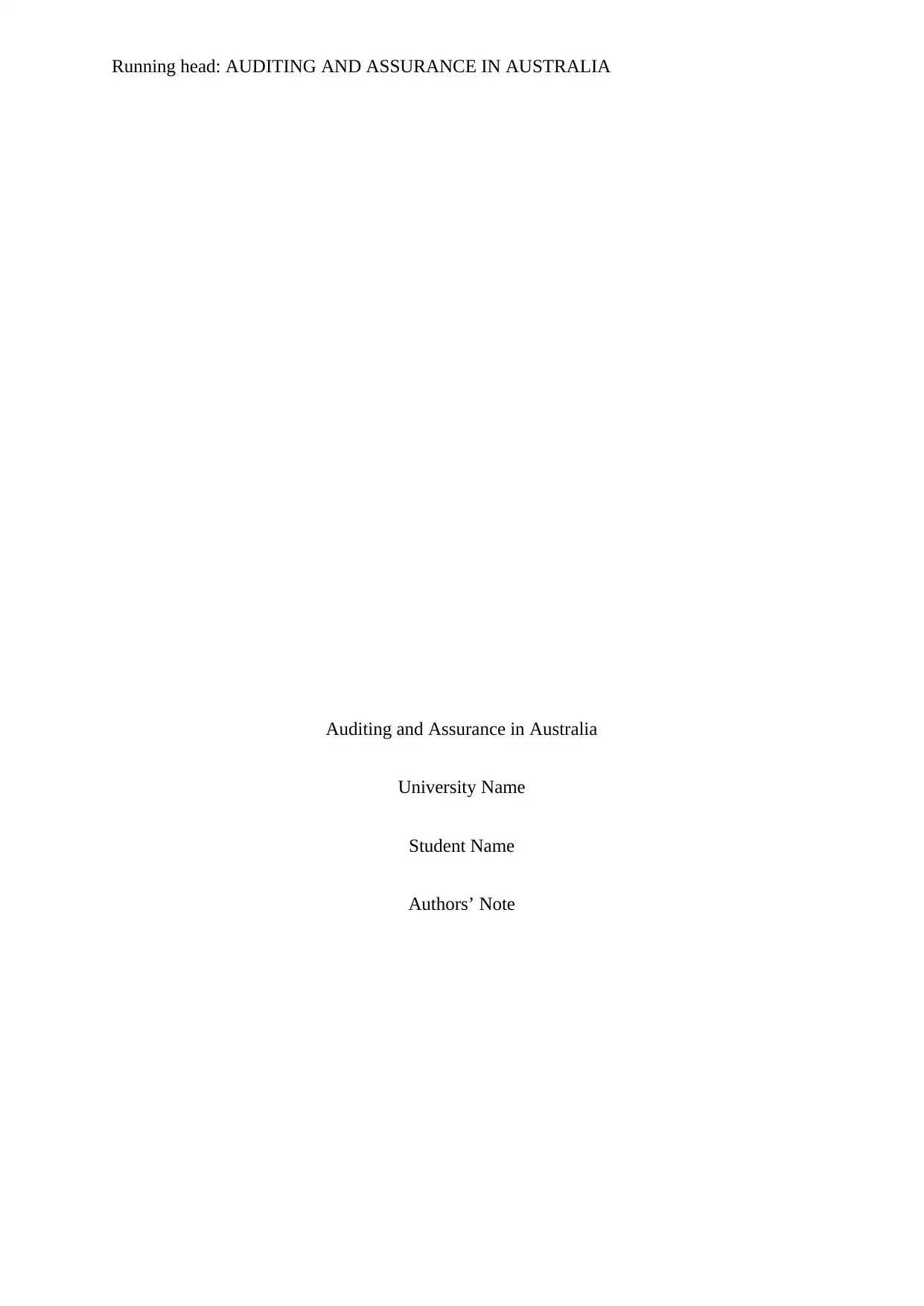
Running head: AUDITING AND ASSURANCE IN AUSTRALIA
Auditing and Assurance in Australia
University Name
Student Name
Authors’ Note
Auditing and Assurance in Australia
University Name
Student Name
Authors’ Note
Paraphrase This Document
Need a fresh take? Get an instant paraphrase of this document with our AI Paraphraser
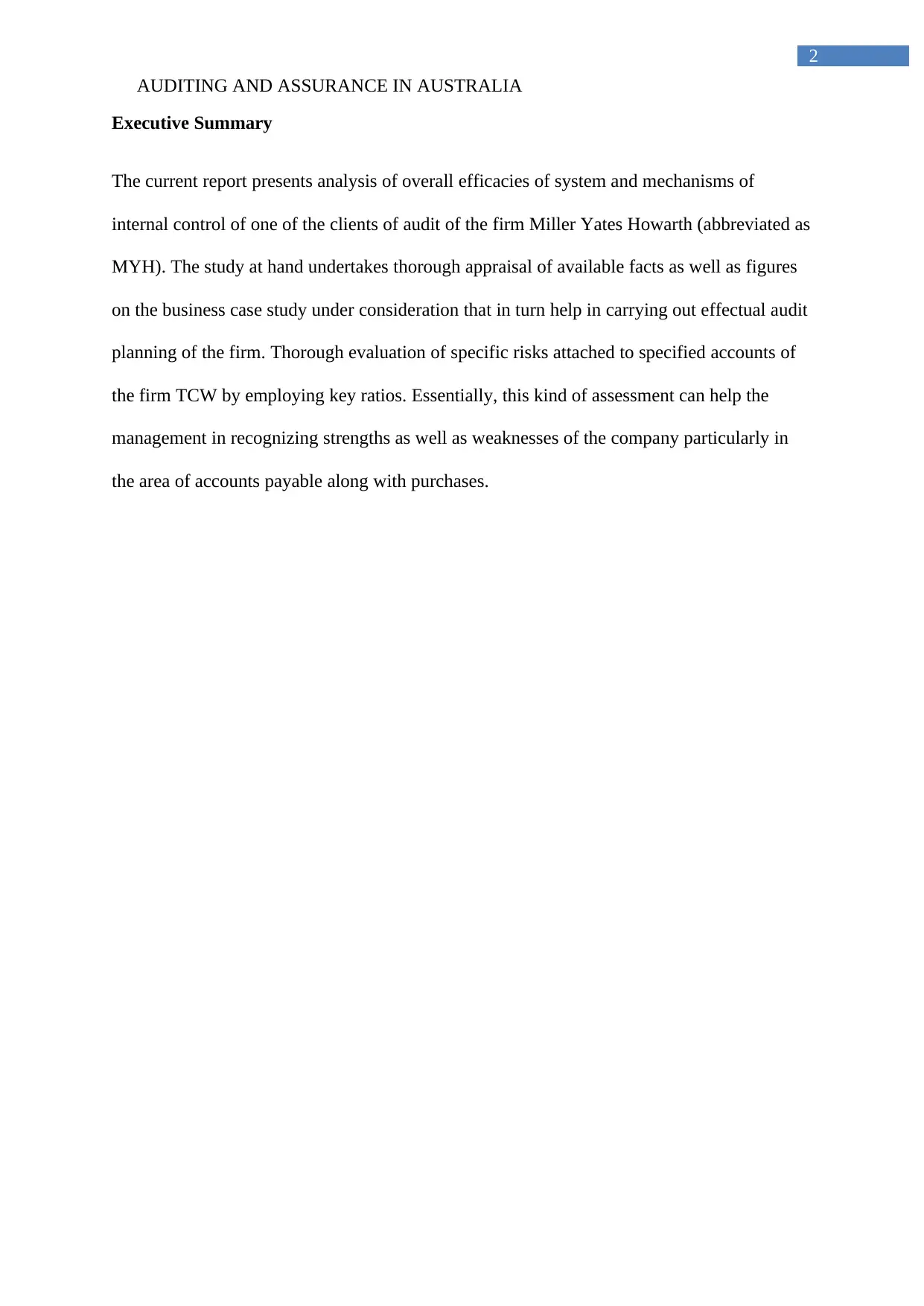
2
AUDITING AND ASSURANCE IN AUSTRALIA
Executive Summary
The current report presents analysis of overall efficacies of system and mechanisms of
internal control of one of the clients of audit of the firm Miller Yates Howarth (abbreviated as
MYH). The study at hand undertakes thorough appraisal of available facts as well as figures
on the business case study under consideration that in turn help in carrying out effectual audit
planning of the firm. Thorough evaluation of specific risks attached to specified accounts of
the firm TCW by employing key ratios. Essentially, this kind of assessment can help the
management in recognizing strengths as well as weaknesses of the company particularly in
the area of accounts payable along with purchases.
AUDITING AND ASSURANCE IN AUSTRALIA
Executive Summary
The current report presents analysis of overall efficacies of system and mechanisms of
internal control of one of the clients of audit of the firm Miller Yates Howarth (abbreviated as
MYH). The study at hand undertakes thorough appraisal of available facts as well as figures
on the business case study under consideration that in turn help in carrying out effectual audit
planning of the firm. Thorough evaluation of specific risks attached to specified accounts of
the firm TCW by employing key ratios. Essentially, this kind of assessment can help the
management in recognizing strengths as well as weaknesses of the company particularly in
the area of accounts payable along with purchases.
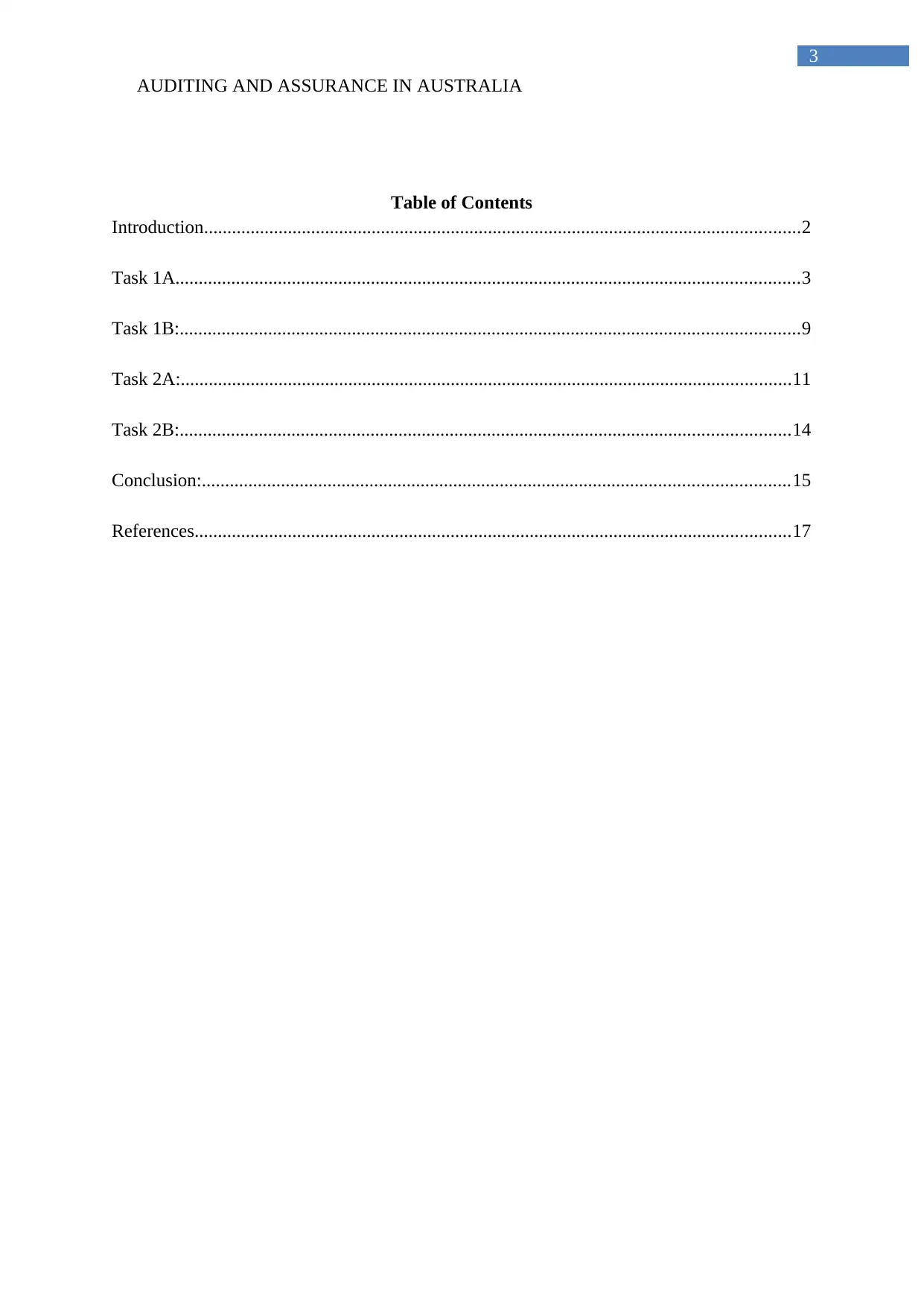
3
AUDITING AND ASSURANCE IN AUSTRALIA
Table of Contents
Introduction................................................................................................................................2
Task 1A......................................................................................................................................3
Task 1B:.....................................................................................................................................9
Task 2A:...................................................................................................................................11
Task 2B:...................................................................................................................................14
Conclusion:..............................................................................................................................15
References................................................................................................................................17
AUDITING AND ASSURANCE IN AUSTRALIA
Table of Contents
Introduction................................................................................................................................2
Task 1A......................................................................................................................................3
Task 1B:.....................................................................................................................................9
Task 2A:...................................................................................................................................11
Task 2B:...................................................................................................................................14
Conclusion:..............................................................................................................................15
References................................................................................................................................17
You're viewing a preview
Unlock full access by subscribing today!
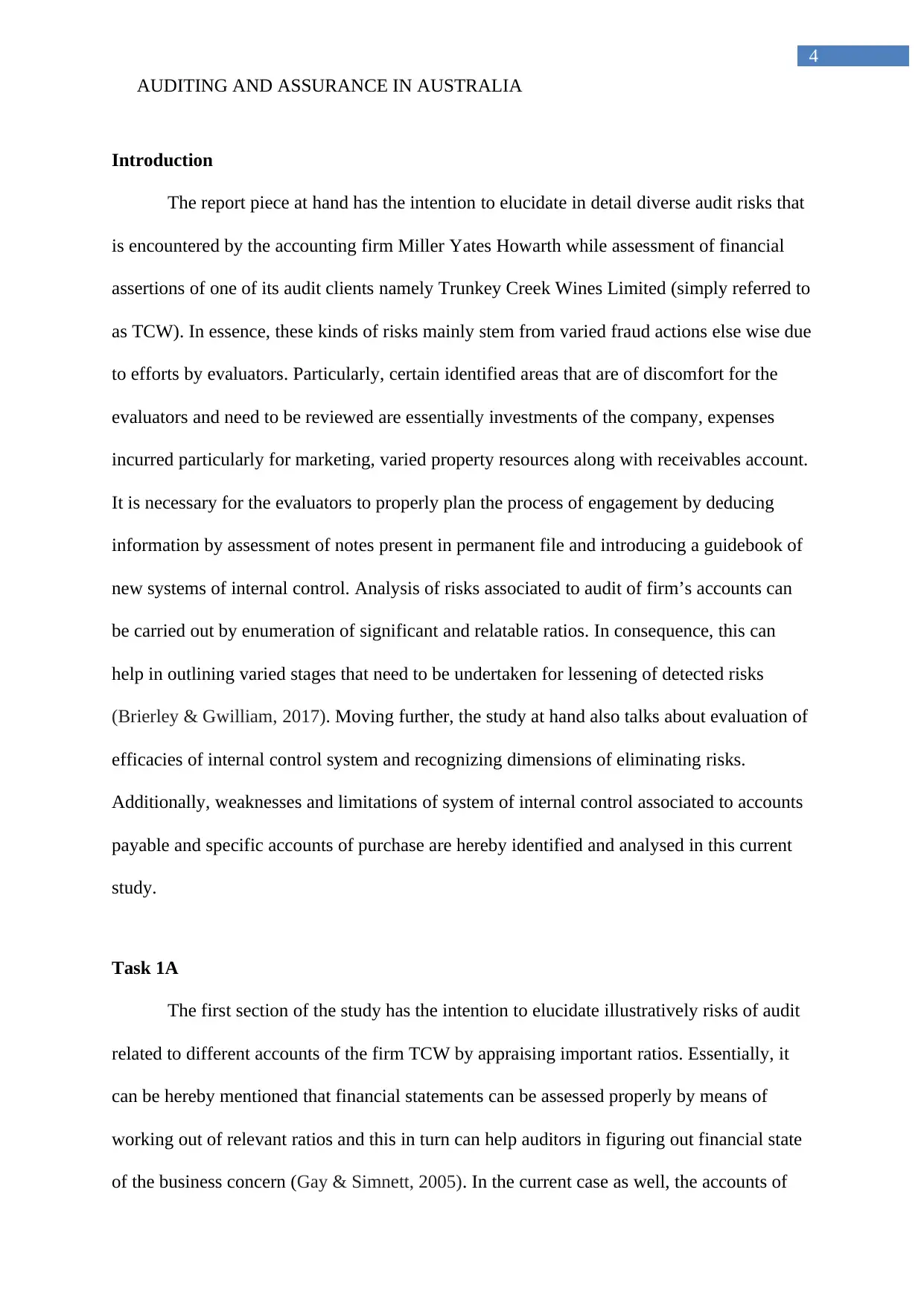
4
AUDITING AND ASSURANCE IN AUSTRALIA
Introduction
The report piece at hand has the intention to elucidate in detail diverse audit risks that
is encountered by the accounting firm Miller Yates Howarth while assessment of financial
assertions of one of its audit clients namely Trunkey Creek Wines Limited (simply referred to
as TCW). In essence, these kinds of risks mainly stem from varied fraud actions else wise due
to efforts by evaluators. Particularly, certain identified areas that are of discomfort for the
evaluators and need to be reviewed are essentially investments of the company, expenses
incurred particularly for marketing, varied property resources along with receivables account.
It is necessary for the evaluators to properly plan the process of engagement by deducing
information by assessment of notes present in permanent file and introducing a guidebook of
new systems of internal control. Analysis of risks associated to audit of firm’s accounts can
be carried out by enumeration of significant and relatable ratios. In consequence, this can
help in outlining varied stages that need to be undertaken for lessening of detected risks
(Brierley & Gwilliam, 2017). Moving further, the study at hand also talks about evaluation of
efficacies of internal control system and recognizing dimensions of eliminating risks.
Additionally, weaknesses and limitations of system of internal control associated to accounts
payable and specific accounts of purchase are hereby identified and analysed in this current
study.
Task 1A
The first section of the study has the intention to elucidate illustratively risks of audit
related to different accounts of the firm TCW by appraising important ratios. Essentially, it
can be hereby mentioned that financial statements can be assessed properly by means of
working out of relevant ratios and this in turn can help auditors in figuring out financial state
of the business concern (Gay & Simnett, 2005). In the current case as well, the accounts of
AUDITING AND ASSURANCE IN AUSTRALIA
Introduction
The report piece at hand has the intention to elucidate in detail diverse audit risks that
is encountered by the accounting firm Miller Yates Howarth while assessment of financial
assertions of one of its audit clients namely Trunkey Creek Wines Limited (simply referred to
as TCW). In essence, these kinds of risks mainly stem from varied fraud actions else wise due
to efforts by evaluators. Particularly, certain identified areas that are of discomfort for the
evaluators and need to be reviewed are essentially investments of the company, expenses
incurred particularly for marketing, varied property resources along with receivables account.
It is necessary for the evaluators to properly plan the process of engagement by deducing
information by assessment of notes present in permanent file and introducing a guidebook of
new systems of internal control. Analysis of risks associated to audit of firm’s accounts can
be carried out by enumeration of significant and relatable ratios. In consequence, this can
help in outlining varied stages that need to be undertaken for lessening of detected risks
(Brierley & Gwilliam, 2017). Moving further, the study at hand also talks about evaluation of
efficacies of internal control system and recognizing dimensions of eliminating risks.
Additionally, weaknesses and limitations of system of internal control associated to accounts
payable and specific accounts of purchase are hereby identified and analysed in this current
study.
Task 1A
The first section of the study has the intention to elucidate illustratively risks of audit
related to different accounts of the firm TCW by appraising important ratios. Essentially, it
can be hereby mentioned that financial statements can be assessed properly by means of
working out of relevant ratios and this in turn can help auditors in figuring out financial state
of the business concern (Gay & Simnett, 2005). In the current case as well, the accounts of
Paraphrase This Document
Need a fresh take? Get an instant paraphrase of this document with our AI Paraphraser
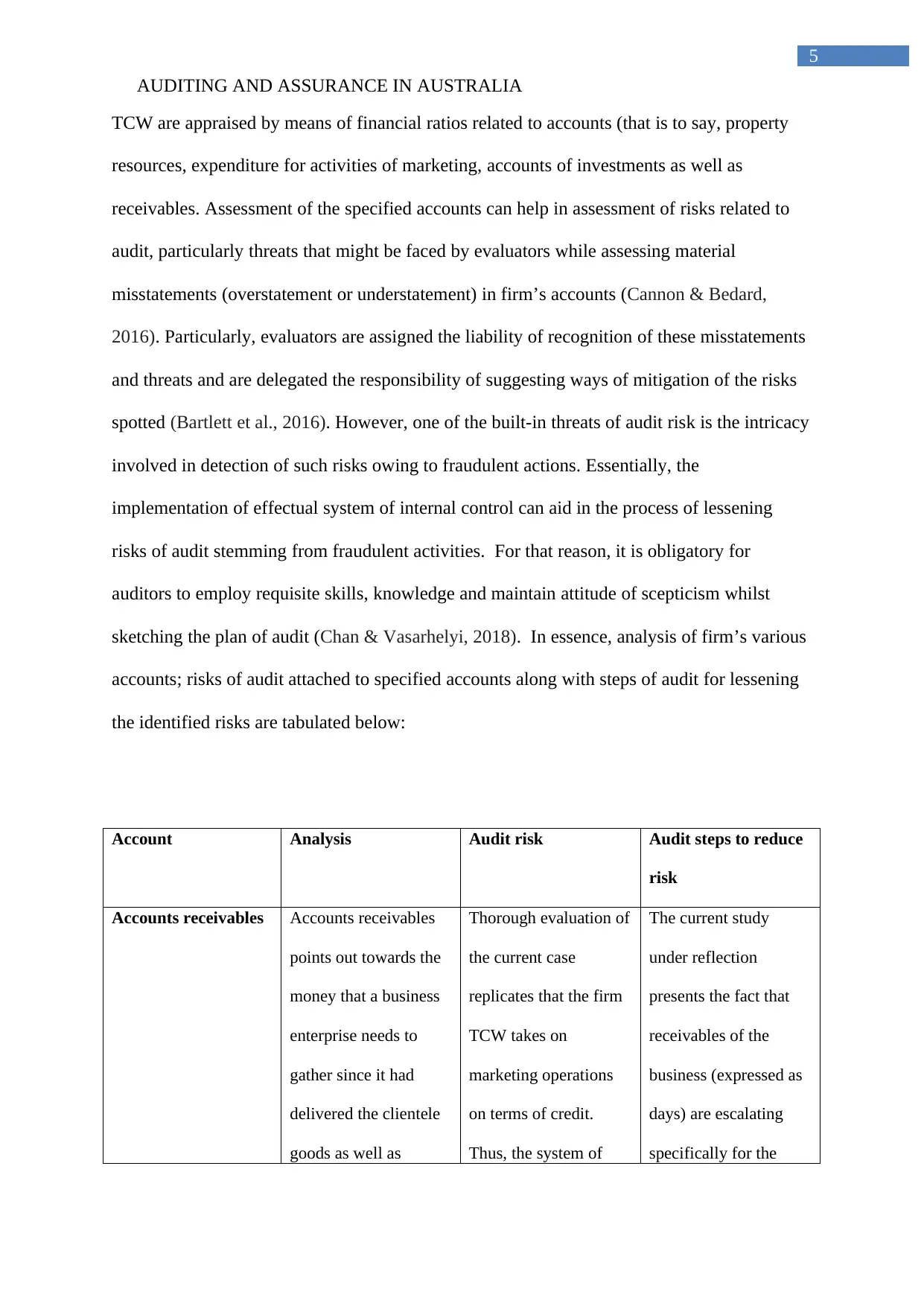
5
AUDITING AND ASSURANCE IN AUSTRALIA
TCW are appraised by means of financial ratios related to accounts (that is to say, property
resources, expenditure for activities of marketing, accounts of investments as well as
receivables. Assessment of the specified accounts can help in assessment of risks related to
audit, particularly threats that might be faced by evaluators while assessing material
misstatements (overstatement or understatement) in firm’s accounts (Cannon & Bedard,
2016). Particularly, evaluators are assigned the liability of recognition of these misstatements
and threats and are delegated the responsibility of suggesting ways of mitigation of the risks
spotted (Bartlett et al., 2016). However, one of the built-in threats of audit risk is the intricacy
involved in detection of such risks owing to fraudulent actions. Essentially, the
implementation of effectual system of internal control can aid in the process of lessening
risks of audit stemming from fraudulent activities. For that reason, it is obligatory for
auditors to employ requisite skills, knowledge and maintain attitude of scepticism whilst
sketching the plan of audit (Chan & Vasarhelyi, 2018). In essence, analysis of firm’s various
accounts; risks of audit attached to specified accounts along with steps of audit for lessening
the identified risks are tabulated below:
Account Analysis Audit risk Audit steps to reduce
risk
Accounts receivables Accounts receivables
points out towards the
money that a business
enterprise needs to
gather since it had
delivered the clientele
goods as well as
Thorough evaluation of
the current case
replicates that the firm
TCW takes on
marketing operations
on terms of credit.
Thus, the system of
The current study
under reflection
presents the fact that
receivables of the
business (expressed as
days) are escalating
specifically for the
AUDITING AND ASSURANCE IN AUSTRALIA
TCW are appraised by means of financial ratios related to accounts (that is to say, property
resources, expenditure for activities of marketing, accounts of investments as well as
receivables. Assessment of the specified accounts can help in assessment of risks related to
audit, particularly threats that might be faced by evaluators while assessing material
misstatements (overstatement or understatement) in firm’s accounts (Cannon & Bedard,
2016). Particularly, evaluators are assigned the liability of recognition of these misstatements
and threats and are delegated the responsibility of suggesting ways of mitigation of the risks
spotted (Bartlett et al., 2016). However, one of the built-in threats of audit risk is the intricacy
involved in detection of such risks owing to fraudulent actions. Essentially, the
implementation of effectual system of internal control can aid in the process of lessening
risks of audit stemming from fraudulent activities. For that reason, it is obligatory for
auditors to employ requisite skills, knowledge and maintain attitude of scepticism whilst
sketching the plan of audit (Chan & Vasarhelyi, 2018). In essence, analysis of firm’s various
accounts; risks of audit attached to specified accounts along with steps of audit for lessening
the identified risks are tabulated below:
Account Analysis Audit risk Audit steps to reduce
risk
Accounts receivables Accounts receivables
points out towards the
money that a business
enterprise needs to
gather since it had
delivered the clientele
goods as well as
Thorough evaluation of
the current case
replicates that the firm
TCW takes on
marketing operations
on terms of credit.
Thus, the system of
The current study
under reflection
presents the fact that
receivables of the
business (expressed as
days) are escalating
specifically for the
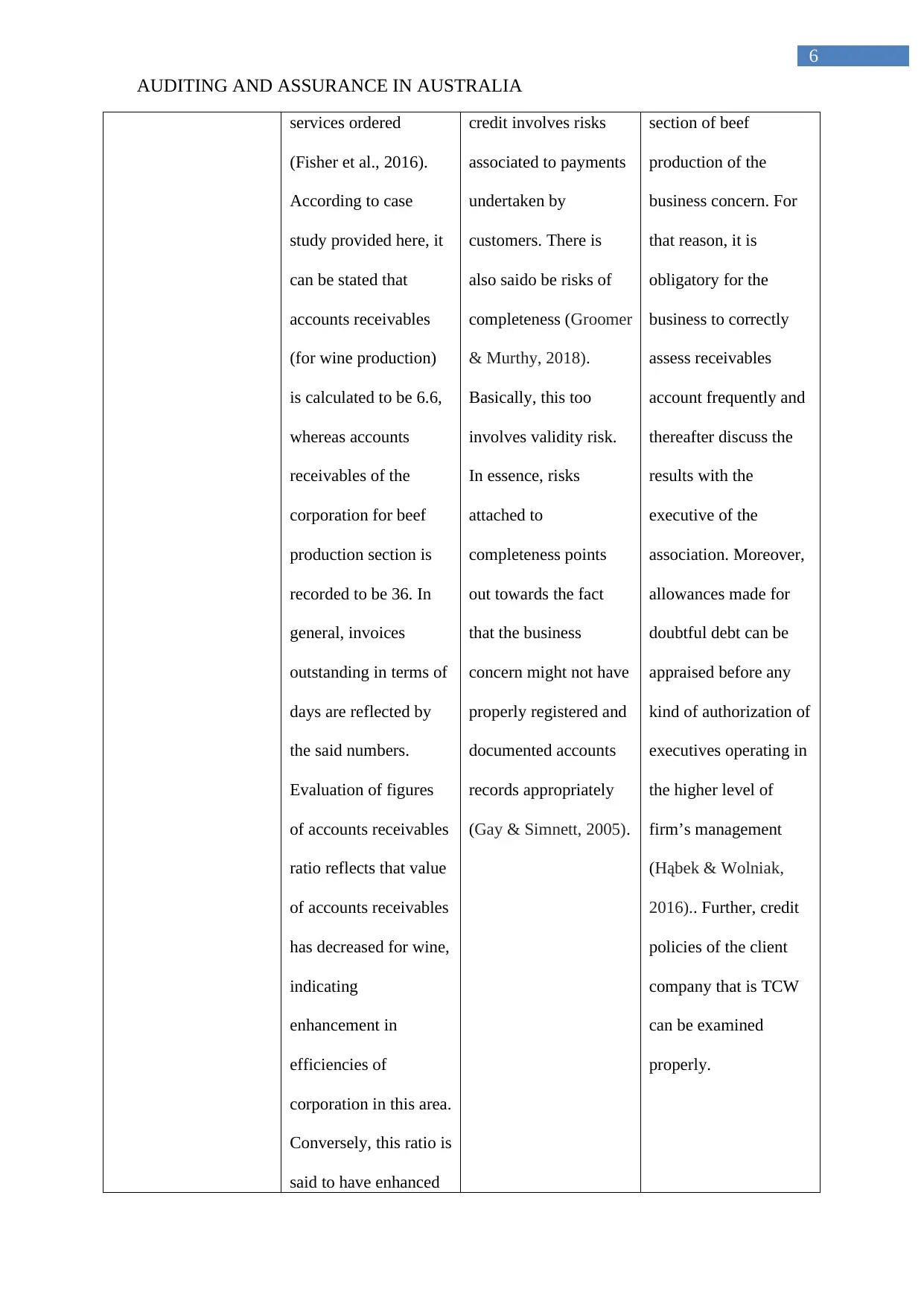
6
AUDITING AND ASSURANCE IN AUSTRALIA
services ordered
(Fisher et al., 2016).
According to case
study provided here, it
can be stated that
accounts receivables
(for wine production)
is calculated to be 6.6,
whereas accounts
receivables of the
corporation for beef
production section is
recorded to be 36. In
general, invoices
outstanding in terms of
days are reflected by
the said numbers.
Evaluation of figures
of accounts receivables
ratio reflects that value
of accounts receivables
has decreased for wine,
indicating
enhancement in
efficiencies of
corporation in this area.
Conversely, this ratio is
said to have enhanced
credit involves risks
associated to payments
undertaken by
customers. There is
also saido be risks of
completeness (Groomer
& Murthy, 2018).
Basically, this too
involves validity risk.
In essence, risks
attached to
completeness points
out towards the fact
that the business
concern might not have
properly registered and
documented accounts
records appropriately
(Gay & Simnett, 2005).
section of beef
production of the
business concern. For
that reason, it is
obligatory for the
business to correctly
assess receivables
account frequently and
thereafter discuss the
results with the
executive of the
association. Moreover,
allowances made for
doubtful debt can be
appraised before any
kind of authorization of
executives operating in
the higher level of
firm’s management
(Hąbek & Wolniak,
2016).. Further, credit
policies of the client
company that is TCW
can be examined
properly.
AUDITING AND ASSURANCE IN AUSTRALIA
services ordered
(Fisher et al., 2016).
According to case
study provided here, it
can be stated that
accounts receivables
(for wine production)
is calculated to be 6.6,
whereas accounts
receivables of the
corporation for beef
production section is
recorded to be 36. In
general, invoices
outstanding in terms of
days are reflected by
the said numbers.
Evaluation of figures
of accounts receivables
ratio reflects that value
of accounts receivables
has decreased for wine,
indicating
enhancement in
efficiencies of
corporation in this area.
Conversely, this ratio is
said to have enhanced
credit involves risks
associated to payments
undertaken by
customers. There is
also saido be risks of
completeness (Groomer
& Murthy, 2018).
Basically, this too
involves validity risk.
In essence, risks
attached to
completeness points
out towards the fact
that the business
concern might not have
properly registered and
documented accounts
records appropriately
(Gay & Simnett, 2005).
section of beef
production of the
business concern. For
that reason, it is
obligatory for the
business to correctly
assess receivables
account frequently and
thereafter discuss the
results with the
executive of the
association. Moreover,
allowances made for
doubtful debt can be
appraised before any
kind of authorization of
executives operating in
the higher level of
firm’s management
(Hąbek & Wolniak,
2016).. Further, credit
policies of the client
company that is TCW
can be examined
properly.
You're viewing a preview
Unlock full access by subscribing today!
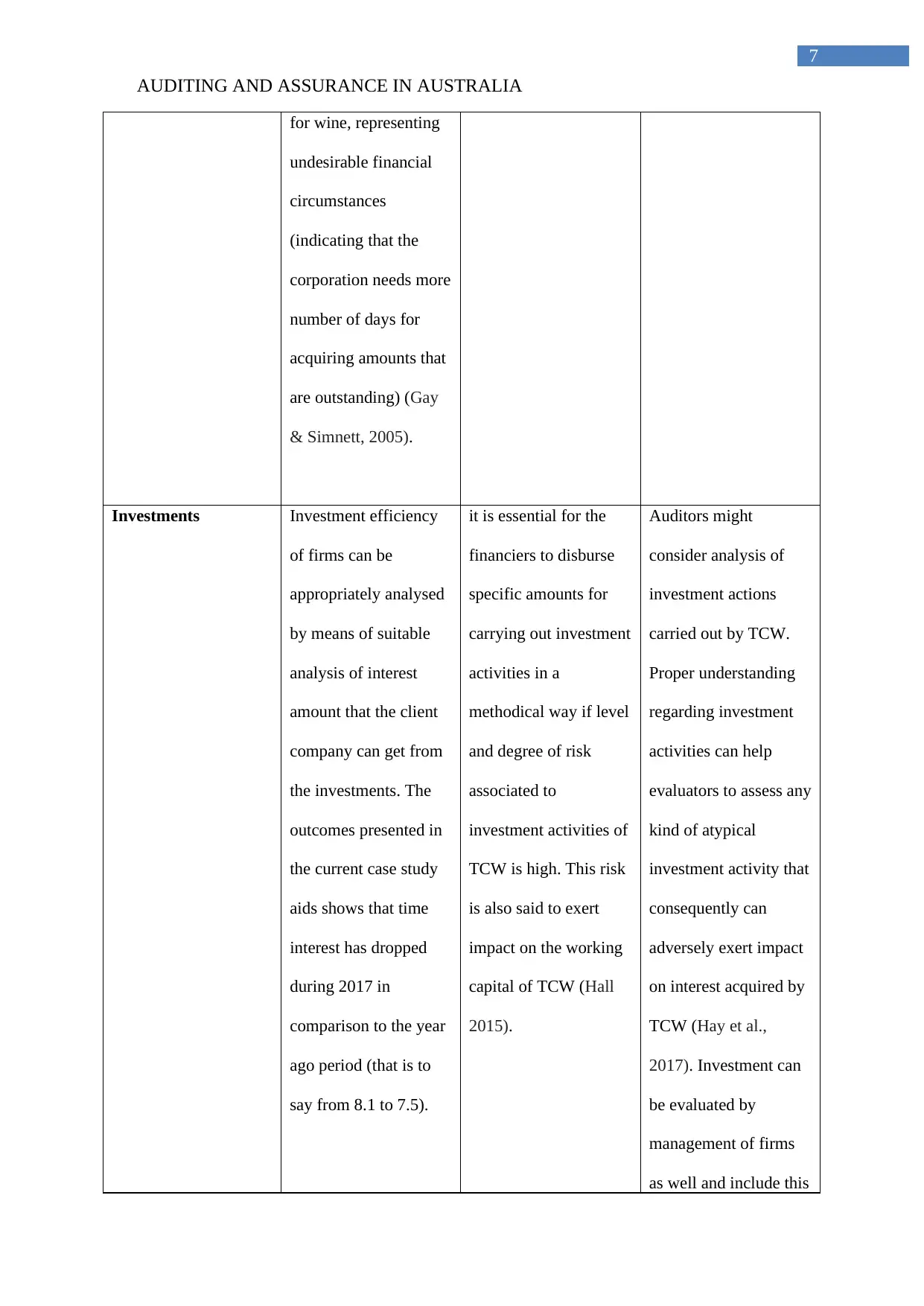
7
AUDITING AND ASSURANCE IN AUSTRALIA
for wine, representing
undesirable financial
circumstances
(indicating that the
corporation needs more
number of days for
acquiring amounts that
are outstanding) (Gay
& Simnett, 2005).
Investments Investment efficiency
of firms can be
appropriately analysed
by means of suitable
analysis of interest
amount that the client
company can get from
the investments. The
outcomes presented in
the current case study
aids shows that time
interest has dropped
during 2017 in
comparison to the year
ago period (that is to
say from 8.1 to 7.5).
it is essential for the
financiers to disburse
specific amounts for
carrying out investment
activities in a
methodical way if level
and degree of risk
associated to
investment activities of
TCW is high. This risk
is also said to exert
impact on the working
capital of TCW (Hall
2015).
Auditors might
consider analysis of
investment actions
carried out by TCW.
Proper understanding
regarding investment
activities can help
evaluators to assess any
kind of atypical
investment activity that
consequently can
adversely exert impact
on interest acquired by
TCW (Hay et al.,
2017). Investment can
be evaluated by
management of firms
as well and include this
AUDITING AND ASSURANCE IN AUSTRALIA
for wine, representing
undesirable financial
circumstances
(indicating that the
corporation needs more
number of days for
acquiring amounts that
are outstanding) (Gay
& Simnett, 2005).
Investments Investment efficiency
of firms can be
appropriately analysed
by means of suitable
analysis of interest
amount that the client
company can get from
the investments. The
outcomes presented in
the current case study
aids shows that time
interest has dropped
during 2017 in
comparison to the year
ago period (that is to
say from 8.1 to 7.5).
it is essential for the
financiers to disburse
specific amounts for
carrying out investment
activities in a
methodical way if level
and degree of risk
associated to
investment activities of
TCW is high. This risk
is also said to exert
impact on the working
capital of TCW (Hall
2015).
Auditors might
consider analysis of
investment actions
carried out by TCW.
Proper understanding
regarding investment
activities can help
evaluators to assess any
kind of atypical
investment activity that
consequently can
adversely exert impact
on interest acquired by
TCW (Hay et al.,
2017). Investment can
be evaluated by
management of firms
as well and include this
Paraphrase This Document
Need a fresh take? Get an instant paraphrase of this document with our AI Paraphraser
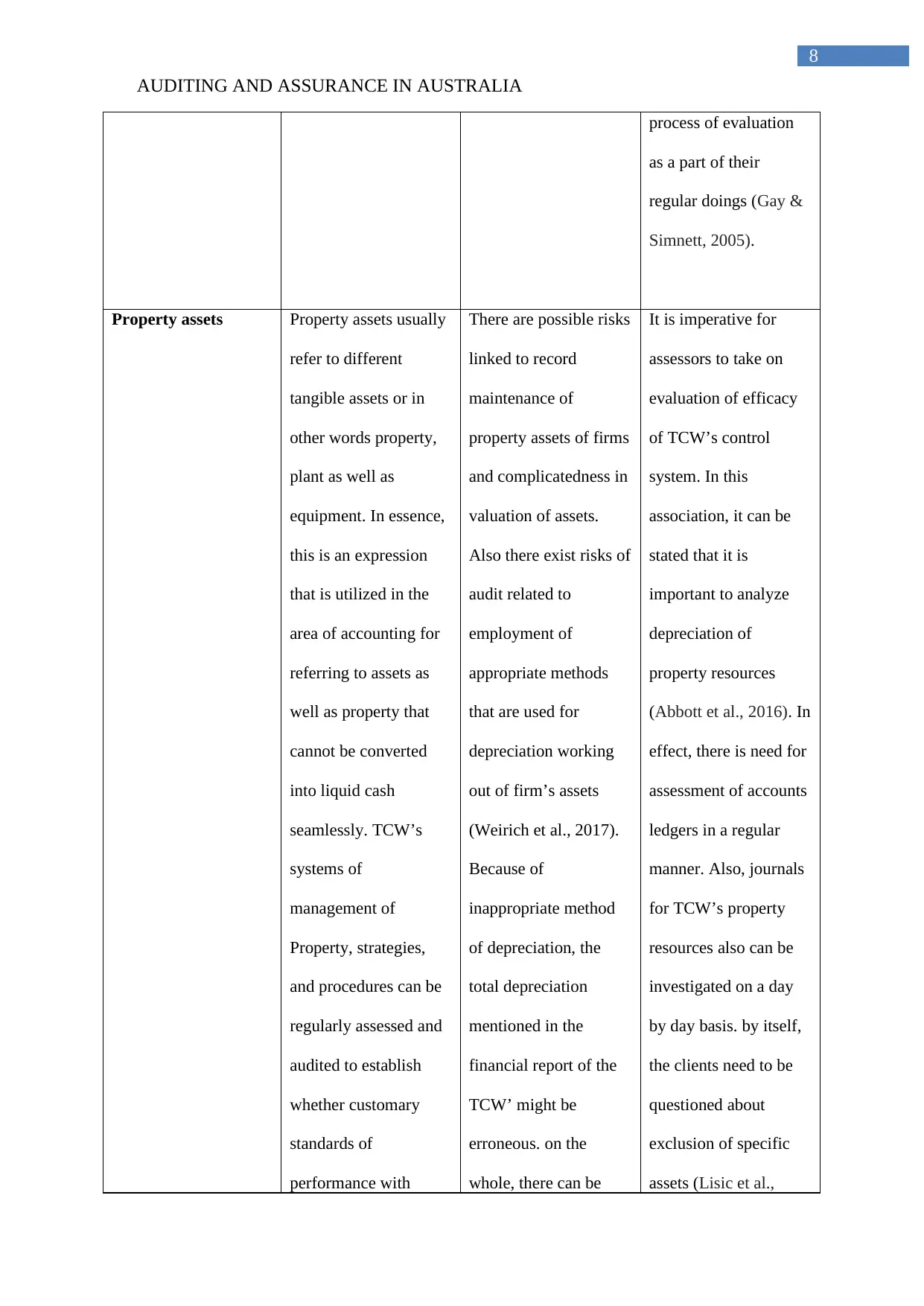
8
AUDITING AND ASSURANCE IN AUSTRALIA
process of evaluation
as a part of their
regular doings (Gay &
Simnett, 2005).
Property assets Property assets usually
refer to different
tangible assets or in
other words property,
plant as well as
equipment. In essence,
this is an expression
that is utilized in the
area of accounting for
referring to assets as
well as property that
cannot be converted
into liquid cash
seamlessly. TCW’s
systems of
management of
Property, strategies,
and procedures can be
regularly assessed and
audited to establish
whether customary
standards of
performance with
There are possible risks
linked to record
maintenance of
property assets of firms
and complicatedness in
valuation of assets.
Also there exist risks of
audit related to
employment of
appropriate methods
that are used for
depreciation working
out of firm’s assets
(Weirich et al., 2017).
Because of
inappropriate method
of depreciation, the
total depreciation
mentioned in the
financial report of the
TCW’ might be
erroneous. on the
whole, there can be
It is imperative for
assessors to take on
evaluation of efficacy
of TCW’s control
system. In this
association, it can be
stated that it is
important to analyze
depreciation of
property resources
(Abbott et al., 2016). In
effect, there is need for
assessment of accounts
ledgers in a regular
manner. Also, journals
for TCW’s property
resources also can be
investigated on a day
by day basis. by itself,
the clients need to be
questioned about
exclusion of specific
assets (Lisic et al.,
AUDITING AND ASSURANCE IN AUSTRALIA
process of evaluation
as a part of their
regular doings (Gay &
Simnett, 2005).
Property assets Property assets usually
refer to different
tangible assets or in
other words property,
plant as well as
equipment. In essence,
this is an expression
that is utilized in the
area of accounting for
referring to assets as
well as property that
cannot be converted
into liquid cash
seamlessly. TCW’s
systems of
management of
Property, strategies,
and procedures can be
regularly assessed and
audited to establish
whether customary
standards of
performance with
There are possible risks
linked to record
maintenance of
property assets of firms
and complicatedness in
valuation of assets.
Also there exist risks of
audit related to
employment of
appropriate methods
that are used for
depreciation working
out of firm’s assets
(Weirich et al., 2017).
Because of
inappropriate method
of depreciation, the
total depreciation
mentioned in the
financial report of the
TCW’ might be
erroneous. on the
whole, there can be
It is imperative for
assessors to take on
evaluation of efficacy
of TCW’s control
system. In this
association, it can be
stated that it is
important to analyze
depreciation of
property resources
(Abbott et al., 2016). In
effect, there is need for
assessment of accounts
ledgers in a regular
manner. Also, journals
for TCW’s property
resources also can be
investigated on a day
by day basis. by itself,
the clients need to be
questioned about
exclusion of specific
assets (Lisic et al.,
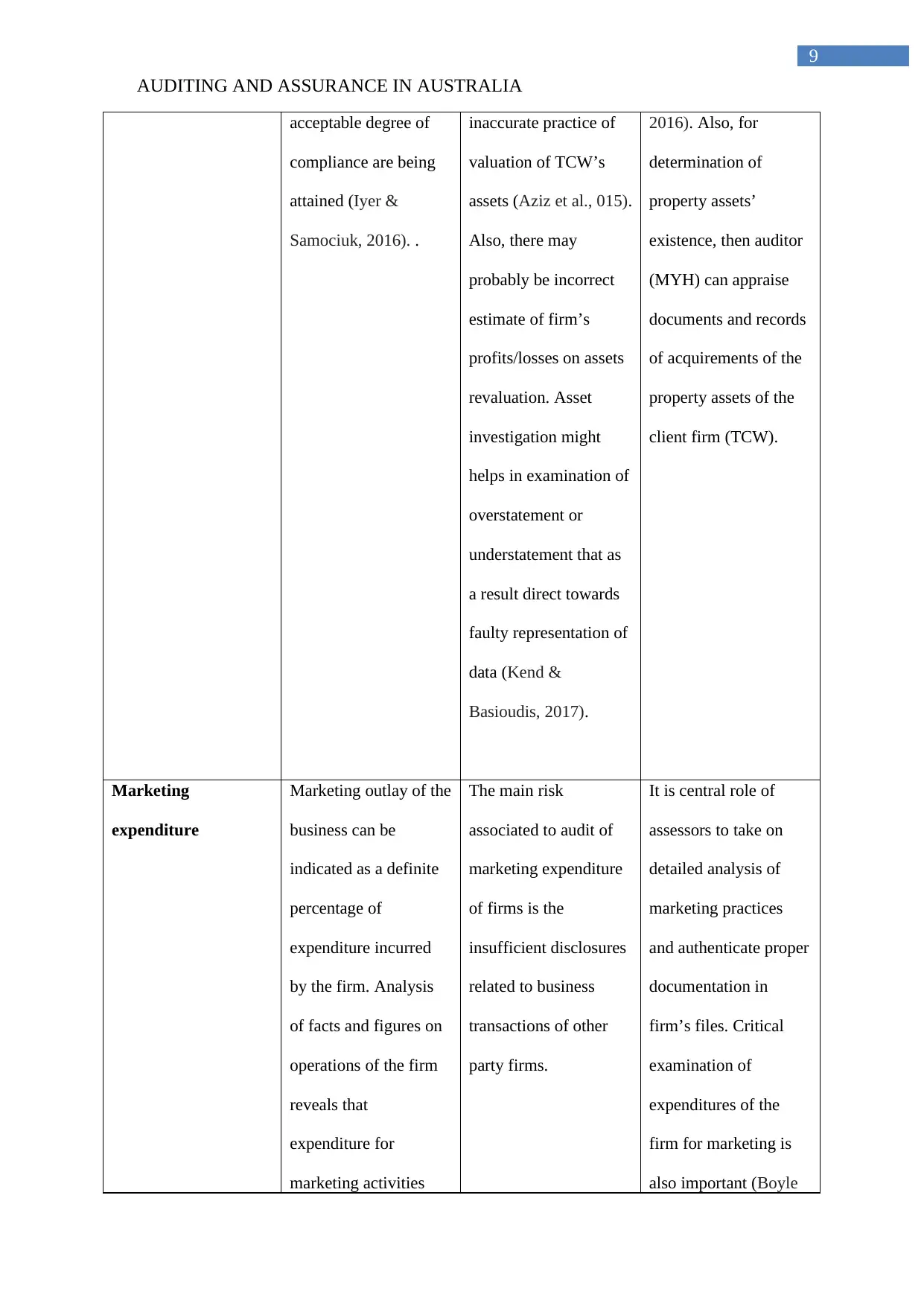
9
AUDITING AND ASSURANCE IN AUSTRALIA
acceptable degree of
compliance are being
attained (Iyer &
Samociuk, 2016). .
inaccurate practice of
valuation of TCW’s
assets (Aziz et al., 015).
Also, there may
probably be incorrect
estimate of firm’s
profits/losses on assets
revaluation. Asset
investigation might
helps in examination of
overstatement or
understatement that as
a result direct towards
faulty representation of
data (Kend &
Basioudis, 2017).
2016). Also, for
determination of
property assets’
existence, then auditor
(MYH) can appraise
documents and records
of acquirements of the
property assets of the
client firm (TCW).
Marketing
expenditure
Marketing outlay of the
business can be
indicated as a definite
percentage of
expenditure incurred
by the firm. Analysis
of facts and figures on
operations of the firm
reveals that
expenditure for
marketing activities
The main risk
associated to audit of
marketing expenditure
of firms is the
insufficient disclosures
related to business
transactions of other
party firms.
It is central role of
assessors to take on
detailed analysis of
marketing practices
and authenticate proper
documentation in
firm’s files. Critical
examination of
expenditures of the
firm for marketing is
also important (Boyle
AUDITING AND ASSURANCE IN AUSTRALIA
acceptable degree of
compliance are being
attained (Iyer &
Samociuk, 2016). .
inaccurate practice of
valuation of TCW’s
assets (Aziz et al., 015).
Also, there may
probably be incorrect
estimate of firm’s
profits/losses on assets
revaluation. Asset
investigation might
helps in examination of
overstatement or
understatement that as
a result direct towards
faulty representation of
data (Kend &
Basioudis, 2017).
2016). Also, for
determination of
property assets’
existence, then auditor
(MYH) can appraise
documents and records
of acquirements of the
property assets of the
client firm (TCW).
Marketing
expenditure
Marketing outlay of the
business can be
indicated as a definite
percentage of
expenditure incurred
by the firm. Analysis
of facts and figures on
operations of the firm
reveals that
expenditure for
marketing activities
The main risk
associated to audit of
marketing expenditure
of firms is the
insufficient disclosures
related to business
transactions of other
party firms.
It is central role of
assessors to take on
detailed analysis of
marketing practices
and authenticate proper
documentation in
firm’s files. Critical
examination of
expenditures of the
firm for marketing is
also important (Boyle
You're viewing a preview
Unlock full access by subscribing today!
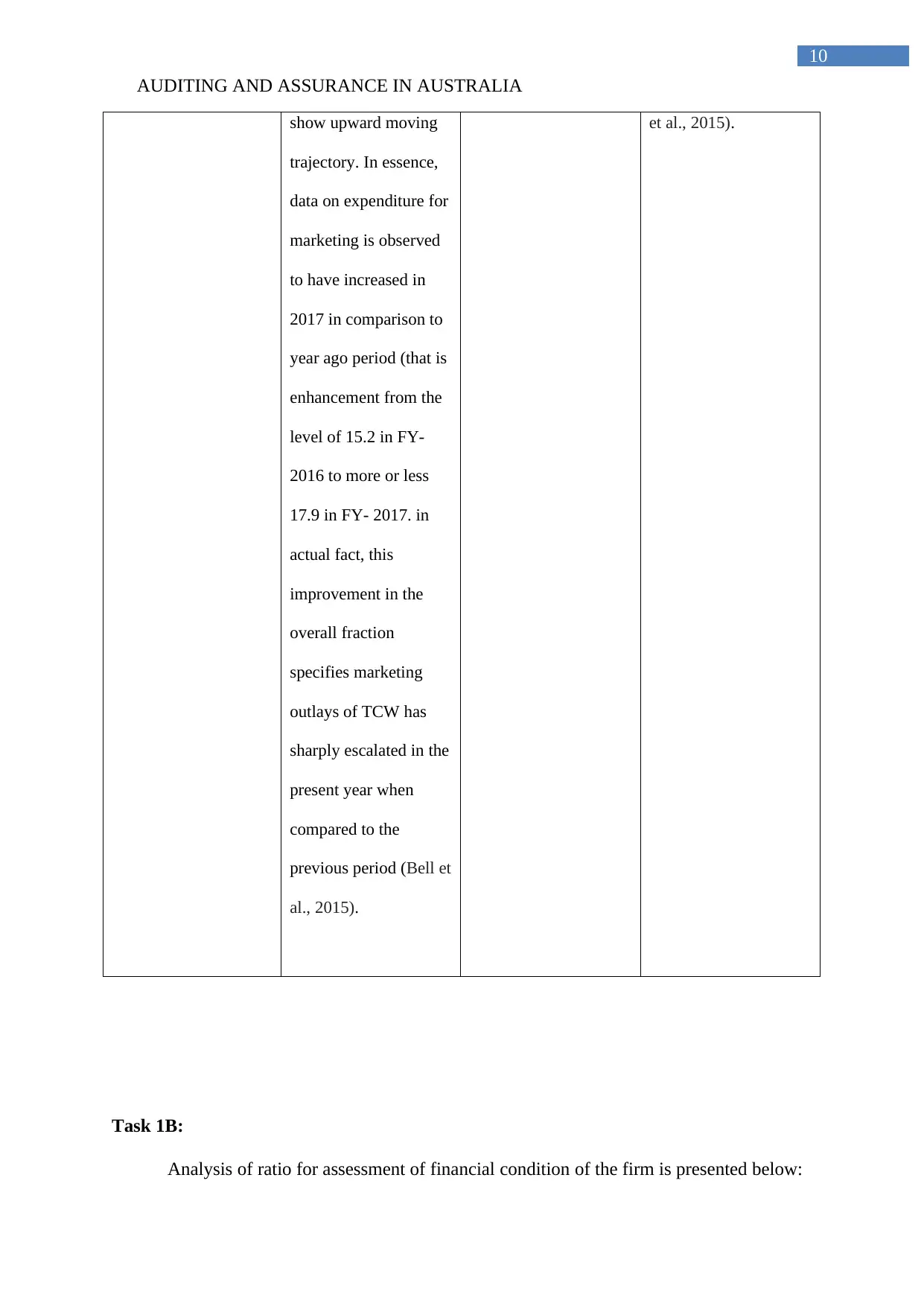
10
AUDITING AND ASSURANCE IN AUSTRALIA
show upward moving
trajectory. In essence,
data on expenditure for
marketing is observed
to have increased in
2017 in comparison to
year ago period (that is
enhancement from the
level of 15.2 in FY-
2016 to more or less
17.9 in FY- 2017. in
actual fact, this
improvement in the
overall fraction
specifies marketing
outlays of TCW has
sharply escalated in the
present year when
compared to the
previous period (Bell et
al., 2015).
et al., 2015).
Task 1B:
Analysis of ratio for assessment of financial condition of the firm is presented below:
AUDITING AND ASSURANCE IN AUSTRALIA
show upward moving
trajectory. In essence,
data on expenditure for
marketing is observed
to have increased in
2017 in comparison to
year ago period (that is
enhancement from the
level of 15.2 in FY-
2016 to more or less
17.9 in FY- 2017. in
actual fact, this
improvement in the
overall fraction
specifies marketing
outlays of TCW has
sharply escalated in the
present year when
compared to the
previous period (Bell et
al., 2015).
et al., 2015).
Task 1B:
Analysis of ratio for assessment of financial condition of the firm is presented below:
Paraphrase This Document
Need a fresh take? Get an instant paraphrase of this document with our AI Paraphraser
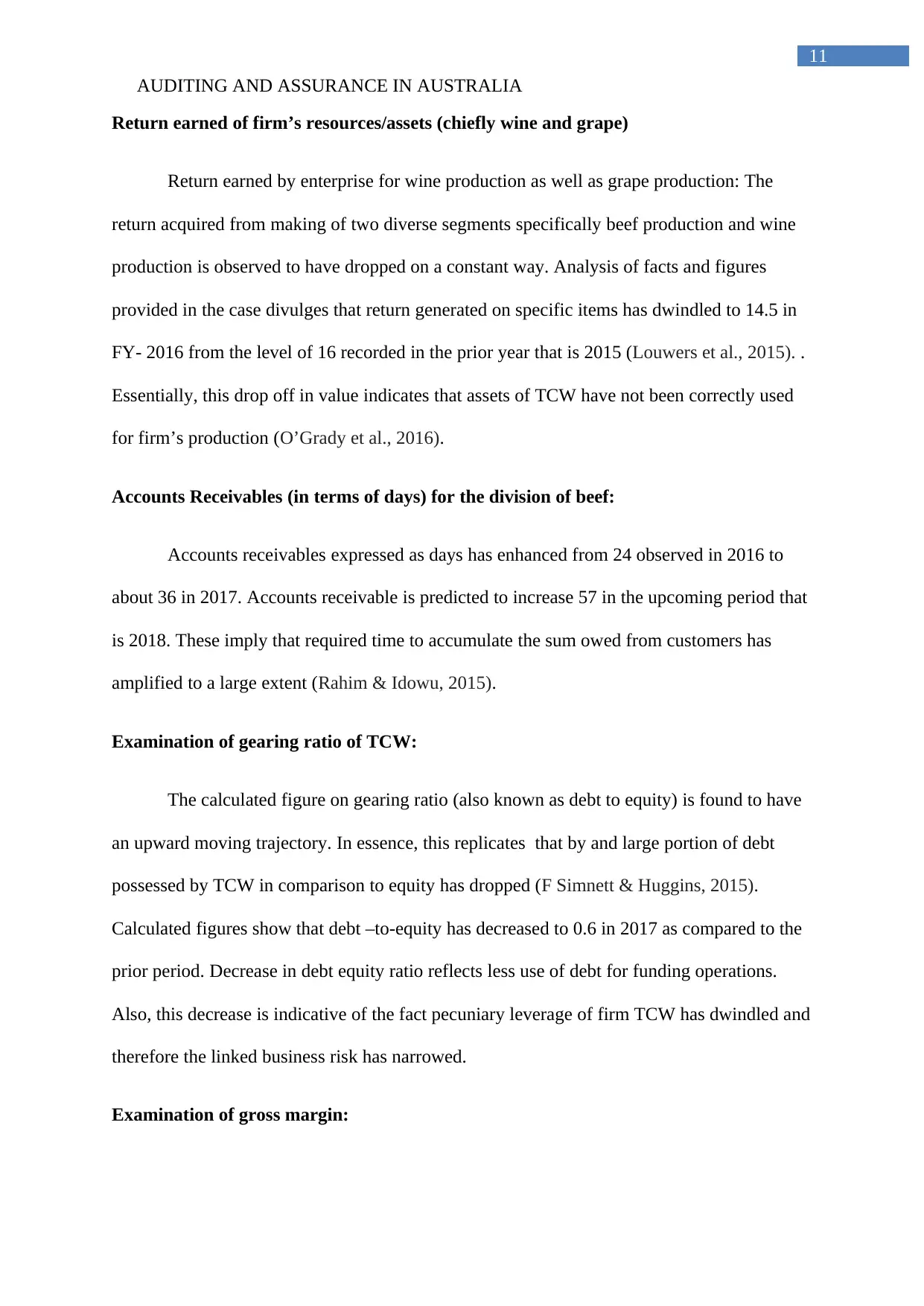
11
AUDITING AND ASSURANCE IN AUSTRALIA
Return earned of firm’s resources/assets (chiefly wine and grape)
Return earned by enterprise for wine production as well as grape production: The
return acquired from making of two diverse segments specifically beef production and wine
production is observed to have dropped on a constant way. Analysis of facts and figures
provided in the case divulges that return generated on specific items has dwindled to 14.5 in
FY- 2016 from the level of 16 recorded in the prior year that is 2015 (Louwers et al., 2015). .
Essentially, this drop off in value indicates that assets of TCW have not been correctly used
for firm’s production (O’Grady et al., 2016).
Accounts Receivables (in terms of days) for the division of beef:
Accounts receivables expressed as days has enhanced from 24 observed in 2016 to
about 36 in 2017. Accounts receivable is predicted to increase 57 in the upcoming period that
is 2018. These imply that required time to accumulate the sum owed from customers has
amplified to a large extent (Rahim & Idowu, 2015).
Examination of gearing ratio of TCW:
The calculated figure on gearing ratio (also known as debt to equity) is found to have
an upward moving trajectory. In essence, this replicates that by and large portion of debt
possessed by TCW in comparison to equity has dropped (F Simnett & Huggins, 2015).
Calculated figures show that debt –to-equity has decreased to 0.6 in 2017 as compared to the
prior period. Decrease in debt equity ratio reflects less use of debt for funding operations.
Also, this decrease is indicative of the fact pecuniary leverage of firm TCW has dwindled and
therefore the linked business risk has narrowed.
Examination of gross margin:
AUDITING AND ASSURANCE IN AUSTRALIA
Return earned of firm’s resources/assets (chiefly wine and grape)
Return earned by enterprise for wine production as well as grape production: The
return acquired from making of two diverse segments specifically beef production and wine
production is observed to have dropped on a constant way. Analysis of facts and figures
provided in the case divulges that return generated on specific items has dwindled to 14.5 in
FY- 2016 from the level of 16 recorded in the prior year that is 2015 (Louwers et al., 2015). .
Essentially, this drop off in value indicates that assets of TCW have not been correctly used
for firm’s production (O’Grady et al., 2016).
Accounts Receivables (in terms of days) for the division of beef:
Accounts receivables expressed as days has enhanced from 24 observed in 2016 to
about 36 in 2017. Accounts receivable is predicted to increase 57 in the upcoming period that
is 2018. These imply that required time to accumulate the sum owed from customers has
amplified to a large extent (Rahim & Idowu, 2015).
Examination of gearing ratio of TCW:
The calculated figure on gearing ratio (also known as debt to equity) is found to have
an upward moving trajectory. In essence, this replicates that by and large portion of debt
possessed by TCW in comparison to equity has dropped (F Simnett & Huggins, 2015).
Calculated figures show that debt –to-equity has decreased to 0.6 in 2017 as compared to the
prior period. Decrease in debt equity ratio reflects less use of debt for funding operations.
Also, this decrease is indicative of the fact pecuniary leverage of firm TCW has dwindled and
therefore the linked business risk has narrowed.
Examination of gross margin:
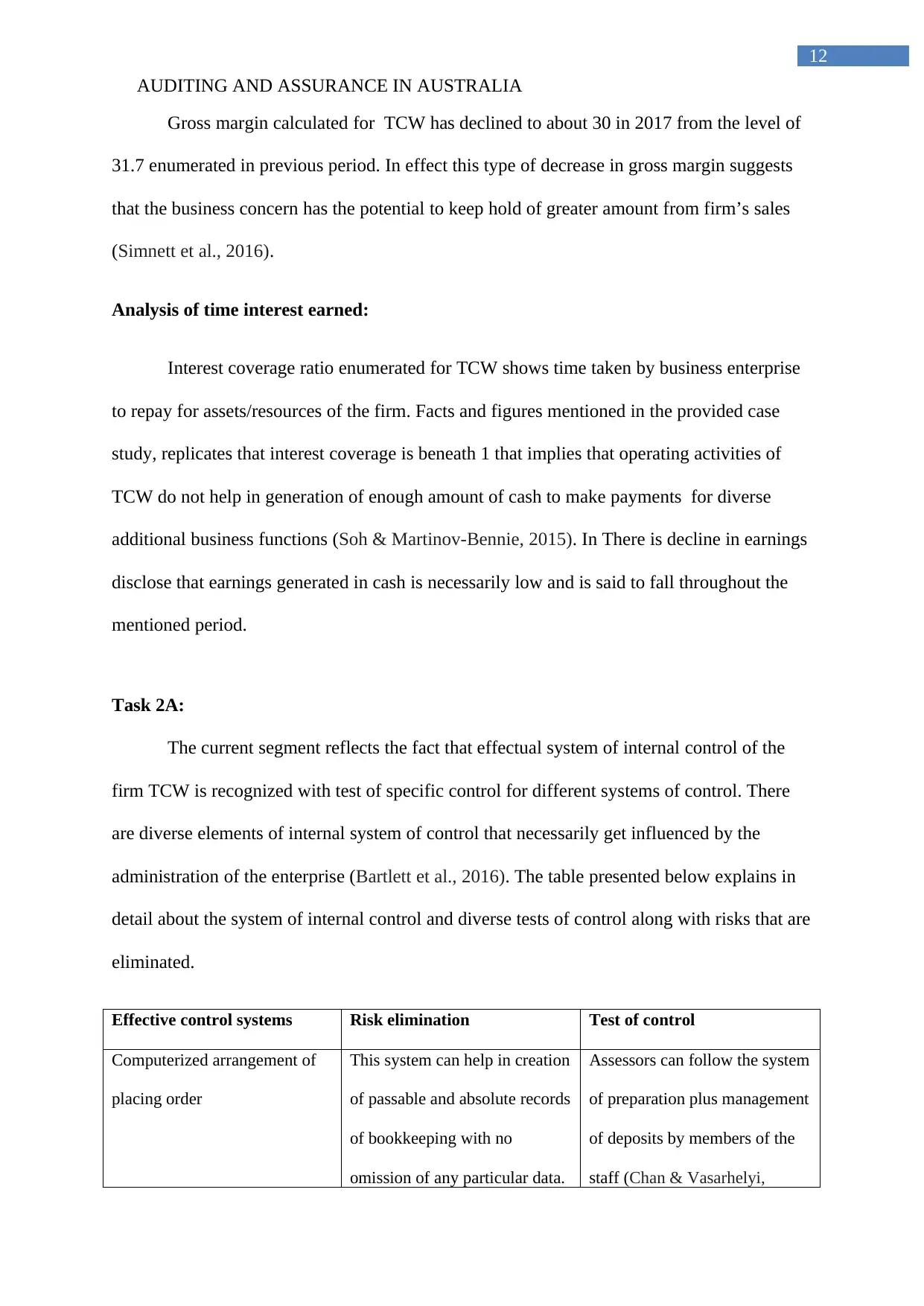
12
AUDITING AND ASSURANCE IN AUSTRALIA
Gross margin calculated for TCW has declined to about 30 in 2017 from the level of
31.7 enumerated in previous period. In effect this type of decrease in gross margin suggests
that the business concern has the potential to keep hold of greater amount from firm’s sales
(Simnett et al., 2016).
Analysis of time interest earned:
Interest coverage ratio enumerated for TCW shows time taken by business enterprise
to repay for assets/resources of the firm. Facts and figures mentioned in the provided case
study, replicates that interest coverage is beneath 1 that implies that operating activities of
TCW do not help in generation of enough amount of cash to make payments for diverse
additional business functions (Soh & Martinov-Bennie, 2015). In There is decline in earnings
disclose that earnings generated in cash is necessarily low and is said to fall throughout the
mentioned period.
Task 2A:
The current segment reflects the fact that effectual system of internal control of the
firm TCW is recognized with test of specific control for different systems of control. There
are diverse elements of internal system of control that necessarily get influenced by the
administration of the enterprise (Bartlett et al., 2016). The table presented below explains in
detail about the system of internal control and diverse tests of control along with risks that are
eliminated.
Effective control systems Risk elimination Test of control
Computerized arrangement of
placing order
This system can help in creation
of passable and absolute records
of bookkeeping with no
omission of any particular data.
Assessors can follow the system
of preparation plus management
of deposits by members of the
staff (Chan & Vasarhelyi,
AUDITING AND ASSURANCE IN AUSTRALIA
Gross margin calculated for TCW has declined to about 30 in 2017 from the level of
31.7 enumerated in previous period. In effect this type of decrease in gross margin suggests
that the business concern has the potential to keep hold of greater amount from firm’s sales
(Simnett et al., 2016).
Analysis of time interest earned:
Interest coverage ratio enumerated for TCW shows time taken by business enterprise
to repay for assets/resources of the firm. Facts and figures mentioned in the provided case
study, replicates that interest coverage is beneath 1 that implies that operating activities of
TCW do not help in generation of enough amount of cash to make payments for diverse
additional business functions (Soh & Martinov-Bennie, 2015). In There is decline in earnings
disclose that earnings generated in cash is necessarily low and is said to fall throughout the
mentioned period.
Task 2A:
The current segment reflects the fact that effectual system of internal control of the
firm TCW is recognized with test of specific control for different systems of control. There
are diverse elements of internal system of control that necessarily get influenced by the
administration of the enterprise (Bartlett et al., 2016). The table presented below explains in
detail about the system of internal control and diverse tests of control along with risks that are
eliminated.
Effective control systems Risk elimination Test of control
Computerized arrangement of
placing order
This system can help in creation
of passable and absolute records
of bookkeeping with no
omission of any particular data.
Assessors can follow the system
of preparation plus management
of deposits by members of the
staff (Chan & Vasarhelyi,
You're viewing a preview
Unlock full access by subscribing today!
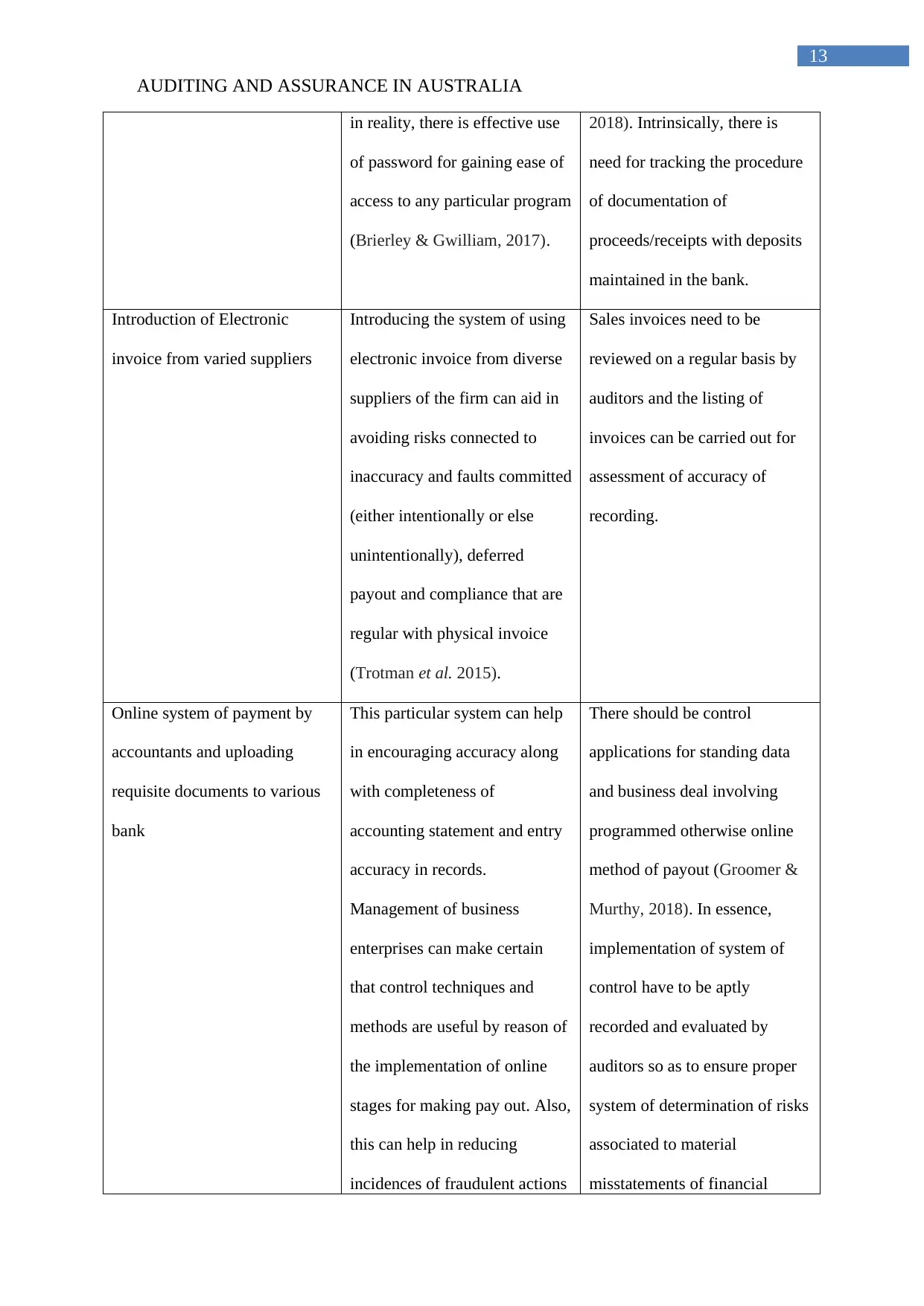
13
AUDITING AND ASSURANCE IN AUSTRALIA
in reality, there is effective use
of password for gaining ease of
access to any particular program
(Brierley & Gwilliam, 2017).
2018). Intrinsically, there is
need for tracking the procedure
of documentation of
proceeds/receipts with deposits
maintained in the bank.
Introduction of Electronic
invoice from varied suppliers
Introducing the system of using
electronic invoice from diverse
suppliers of the firm can aid in
avoiding risks connected to
inaccuracy and faults committed
(either intentionally or else
unintentionally), deferred
payout and compliance that are
regular with physical invoice
(Trotman et al. 2015).
Sales invoices need to be
reviewed on a regular basis by
auditors and the listing of
invoices can be carried out for
assessment of accuracy of
recording.
Online system of payment by
accountants and uploading
requisite documents to various
bank
This particular system can help
in encouraging accuracy along
with completeness of
accounting statement and entry
accuracy in records.
Management of business
enterprises can make certain
that control techniques and
methods are useful by reason of
the implementation of online
stages for making pay out. Also,
this can help in reducing
incidences of fraudulent actions
There should be control
applications for standing data
and business deal involving
programmed otherwise online
method of payout (Groomer &
Murthy, 2018). In essence,
implementation of system of
control have to be aptly
recorded and evaluated by
auditors so as to ensure proper
system of determination of risks
associated to material
misstatements of financial
AUDITING AND ASSURANCE IN AUSTRALIA
in reality, there is effective use
of password for gaining ease of
access to any particular program
(Brierley & Gwilliam, 2017).
2018). Intrinsically, there is
need for tracking the procedure
of documentation of
proceeds/receipts with deposits
maintained in the bank.
Introduction of Electronic
invoice from varied suppliers
Introducing the system of using
electronic invoice from diverse
suppliers of the firm can aid in
avoiding risks connected to
inaccuracy and faults committed
(either intentionally or else
unintentionally), deferred
payout and compliance that are
regular with physical invoice
(Trotman et al. 2015).
Sales invoices need to be
reviewed on a regular basis by
auditors and the listing of
invoices can be carried out for
assessment of accuracy of
recording.
Online system of payment by
accountants and uploading
requisite documents to various
bank
This particular system can help
in encouraging accuracy along
with completeness of
accounting statement and entry
accuracy in records.
Management of business
enterprises can make certain
that control techniques and
methods are useful by reason of
the implementation of online
stages for making pay out. Also,
this can help in reducing
incidences of fraudulent actions
There should be control
applications for standing data
and business deal involving
programmed otherwise online
method of payout (Groomer &
Murthy, 2018). In essence,
implementation of system of
control have to be aptly
recorded and evaluated by
auditors so as to ensure proper
system of determination of risks
associated to material
misstatements of financial
Paraphrase This Document
Need a fresh take? Get an instant paraphrase of this document with our AI Paraphraser
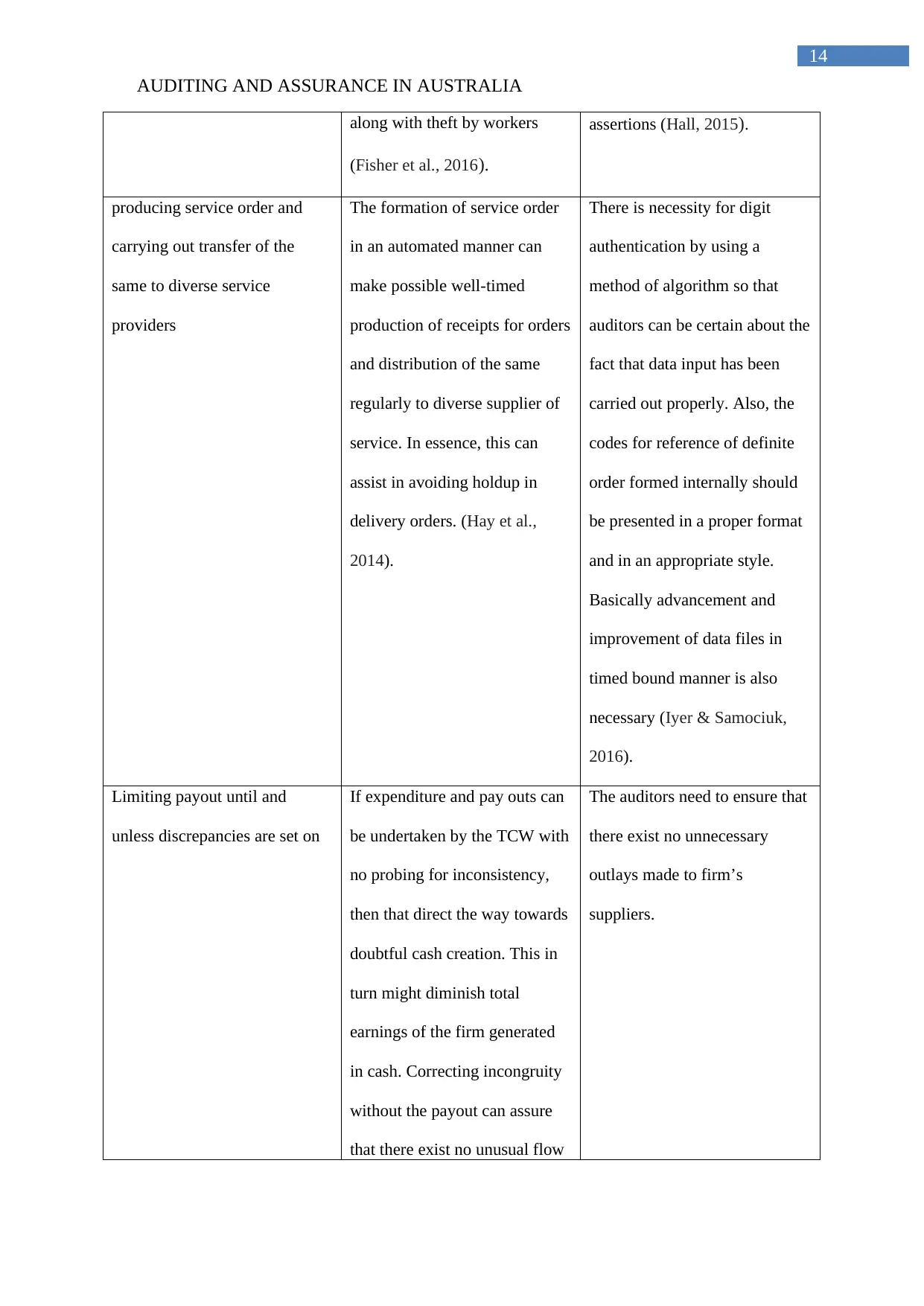
14
AUDITING AND ASSURANCE IN AUSTRALIA
along with theft by workers
(Fisher et al., 2016).
assertions (Hall, 2015).
producing service order and
carrying out transfer of the
same to diverse service
providers
The formation of service order
in an automated manner can
make possible well-timed
production of receipts for orders
and distribution of the same
regularly to diverse supplier of
service. In essence, this can
assist in avoiding holdup in
delivery orders. (Hay et al.,
2014).
There is necessity for digit
authentication by using a
method of algorithm so that
auditors can be certain about the
fact that data input has been
carried out properly. Also, the
codes for reference of definite
order formed internally should
be presented in a proper format
and in an appropriate style.
Basically advancement and
improvement of data files in
timed bound manner is also
necessary (Iyer & Samociuk,
2016).
Limiting payout until and
unless discrepancies are set on
If expenditure and pay outs can
be undertaken by the TCW with
no probing for inconsistency,
then that direct the way towards
doubtful cash creation. This in
turn might diminish total
earnings of the firm generated
in cash. Correcting incongruity
without the payout can assure
that there exist no unusual flow
The auditors need to ensure that
there exist no unnecessary
outlays made to firm’s
suppliers.
AUDITING AND ASSURANCE IN AUSTRALIA
along with theft by workers
(Fisher et al., 2016).
assertions (Hall, 2015).
producing service order and
carrying out transfer of the
same to diverse service
providers
The formation of service order
in an automated manner can
make possible well-timed
production of receipts for orders
and distribution of the same
regularly to diverse supplier of
service. In essence, this can
assist in avoiding holdup in
delivery orders. (Hay et al.,
2014).
There is necessity for digit
authentication by using a
method of algorithm so that
auditors can be certain about the
fact that data input has been
carried out properly. Also, the
codes for reference of definite
order formed internally should
be presented in a proper format
and in an appropriate style.
Basically advancement and
improvement of data files in
timed bound manner is also
necessary (Iyer & Samociuk,
2016).
Limiting payout until and
unless discrepancies are set on
If expenditure and pay outs can
be undertaken by the TCW with
no probing for inconsistency,
then that direct the way towards
doubtful cash creation. This in
turn might diminish total
earnings of the firm generated
in cash. Correcting incongruity
without the payout can assure
that there exist no unusual flow
The auditors need to ensure that
there exist no unnecessary
outlays made to firm’s
suppliers.
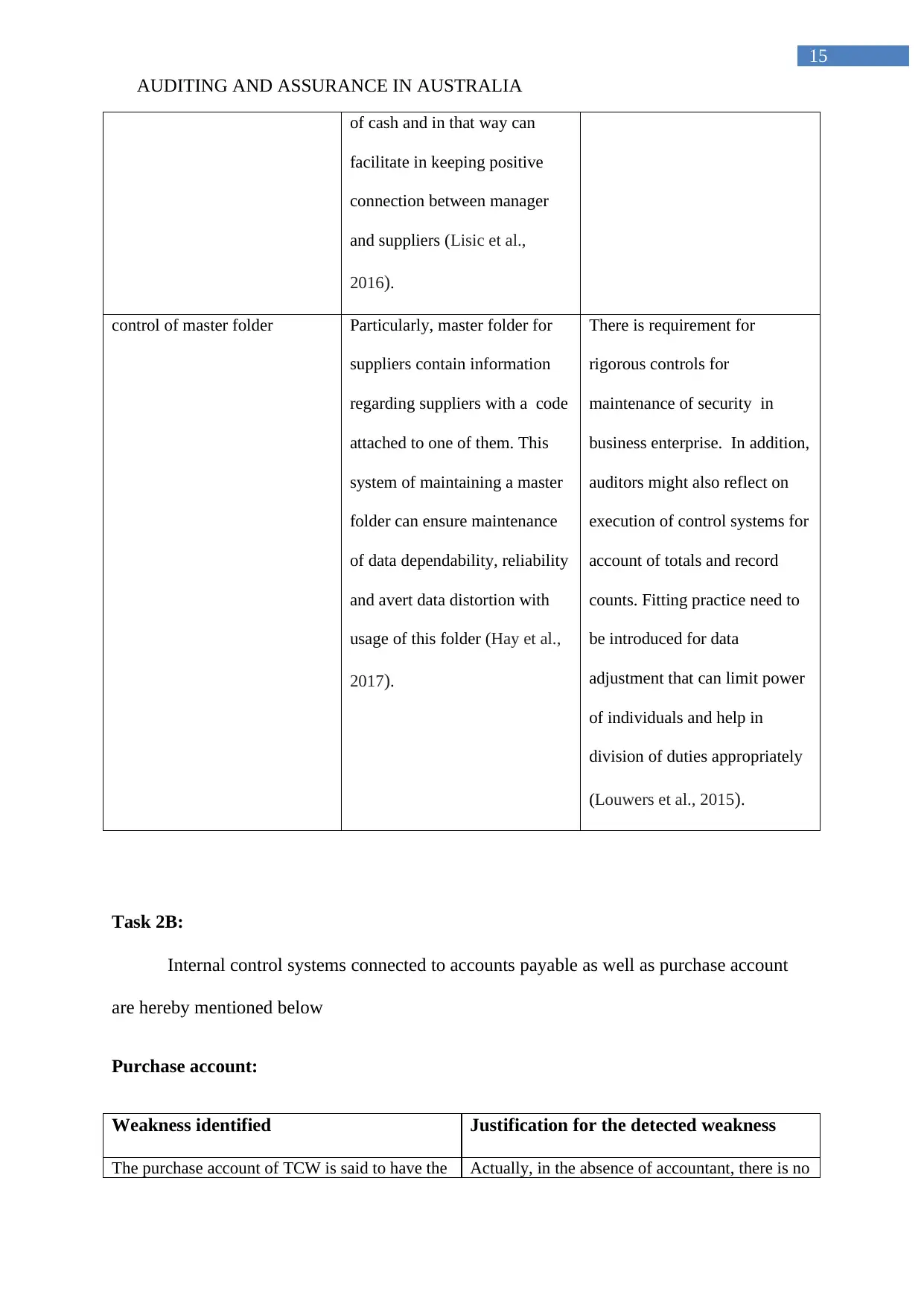
15
AUDITING AND ASSURANCE IN AUSTRALIA
of cash and in that way can
facilitate in keeping positive
connection between manager
and suppliers (Lisic et al.,
2016).
control of master folder Particularly, master folder for
suppliers contain information
regarding suppliers with a code
attached to one of them. This
system of maintaining a master
folder can ensure maintenance
of data dependability, reliability
and avert data distortion with
usage of this folder (Hay et al.,
2017).
There is requirement for
rigorous controls for
maintenance of security in
business enterprise. In addition,
auditors might also reflect on
execution of control systems for
account of totals and record
counts. Fitting practice need to
be introduced for data
adjustment that can limit power
of individuals and help in
division of duties appropriately
(Louwers et al., 2015).
Task 2B:
Internal control systems connected to accounts payable as well as purchase account
are hereby mentioned below
Purchase account:
Weakness identified Justification for the detected weakness
The purchase account of TCW is said to have the Actually, in the absence of accountant, there is no
AUDITING AND ASSURANCE IN AUSTRALIA
of cash and in that way can
facilitate in keeping positive
connection between manager
and suppliers (Lisic et al.,
2016).
control of master folder Particularly, master folder for
suppliers contain information
regarding suppliers with a code
attached to one of them. This
system of maintaining a master
folder can ensure maintenance
of data dependability, reliability
and avert data distortion with
usage of this folder (Hay et al.,
2017).
There is requirement for
rigorous controls for
maintenance of security in
business enterprise. In addition,
auditors might also reflect on
execution of control systems for
account of totals and record
counts. Fitting practice need to
be introduced for data
adjustment that can limit power
of individuals and help in
division of duties appropriately
(Louwers et al., 2015).
Task 2B:
Internal control systems connected to accounts payable as well as purchase account
are hereby mentioned below
Purchase account:
Weakness identified Justification for the detected weakness
The purchase account of TCW is said to have the Actually, in the absence of accountant, there is no
You're viewing a preview
Unlock full access by subscribing today!
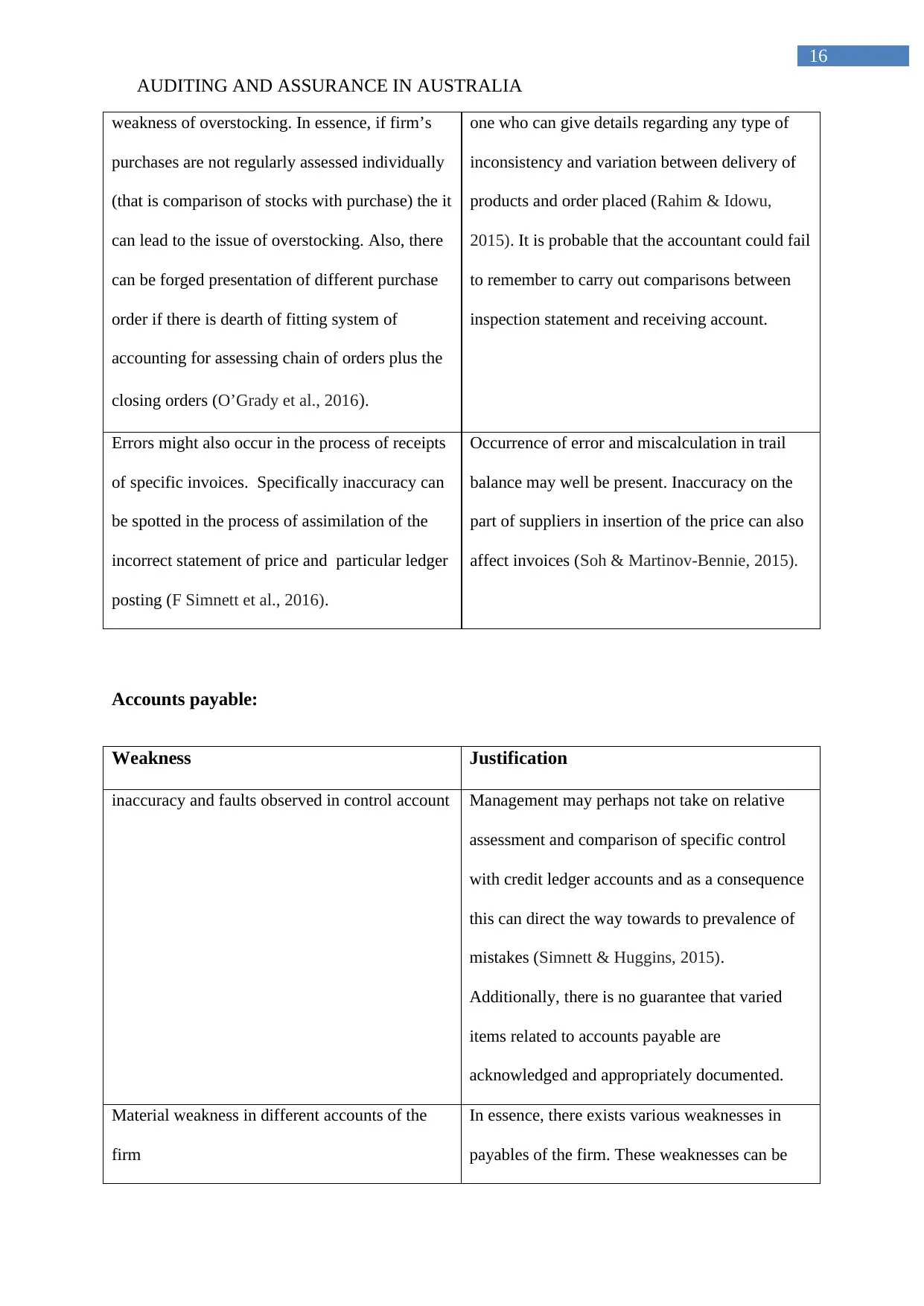
16
AUDITING AND ASSURANCE IN AUSTRALIA
weakness of overstocking. In essence, if firm’s
purchases are not regularly assessed individually
(that is comparison of stocks with purchase) the it
can lead to the issue of overstocking. Also, there
can be forged presentation of different purchase
order if there is dearth of fitting system of
accounting for assessing chain of orders plus the
closing orders (O’Grady et al., 2016).
one who can give details regarding any type of
inconsistency and variation between delivery of
products and order placed (Rahim & Idowu,
2015). It is probable that the accountant could fail
to remember to carry out comparisons between
inspection statement and receiving account.
Errors might also occur in the process of receipts
of specific invoices. Specifically inaccuracy can
be spotted in the process of assimilation of the
incorrect statement of price and particular ledger
posting (F Simnett et al., 2016).
Occurrence of error and miscalculation in trail
balance may well be present. Inaccuracy on the
part of suppliers in insertion of the price can also
affect invoices (Soh & Martinov-Bennie, 2015).
Accounts payable:
Weakness Justification
inaccuracy and faults observed in control account Management may perhaps not take on relative
assessment and comparison of specific control
with credit ledger accounts and as a consequence
this can direct the way towards to prevalence of
mistakes (Simnett & Huggins, 2015).
Additionally, there is no guarantee that varied
items related to accounts payable are
acknowledged and appropriately documented.
Material weakness in different accounts of the
firm
In essence, there exists various weaknesses in
payables of the firm. These weaknesses can be
AUDITING AND ASSURANCE IN AUSTRALIA
weakness of overstocking. In essence, if firm’s
purchases are not regularly assessed individually
(that is comparison of stocks with purchase) the it
can lead to the issue of overstocking. Also, there
can be forged presentation of different purchase
order if there is dearth of fitting system of
accounting for assessing chain of orders plus the
closing orders (O’Grady et al., 2016).
one who can give details regarding any type of
inconsistency and variation between delivery of
products and order placed (Rahim & Idowu,
2015). It is probable that the accountant could fail
to remember to carry out comparisons between
inspection statement and receiving account.
Errors might also occur in the process of receipts
of specific invoices. Specifically inaccuracy can
be spotted in the process of assimilation of the
incorrect statement of price and particular ledger
posting (F Simnett et al., 2016).
Occurrence of error and miscalculation in trail
balance may well be present. Inaccuracy on the
part of suppliers in insertion of the price can also
affect invoices (Soh & Martinov-Bennie, 2015).
Accounts payable:
Weakness Justification
inaccuracy and faults observed in control account Management may perhaps not take on relative
assessment and comparison of specific control
with credit ledger accounts and as a consequence
this can direct the way towards to prevalence of
mistakes (Simnett & Huggins, 2015).
Additionally, there is no guarantee that varied
items related to accounts payable are
acknowledged and appropriately documented.
Material weakness in different accounts of the
firm
In essence, there exists various weaknesses in
payables of the firm. These weaknesses can be
Paraphrase This Document
Need a fresh take? Get an instant paraphrase of this document with our AI Paraphraser
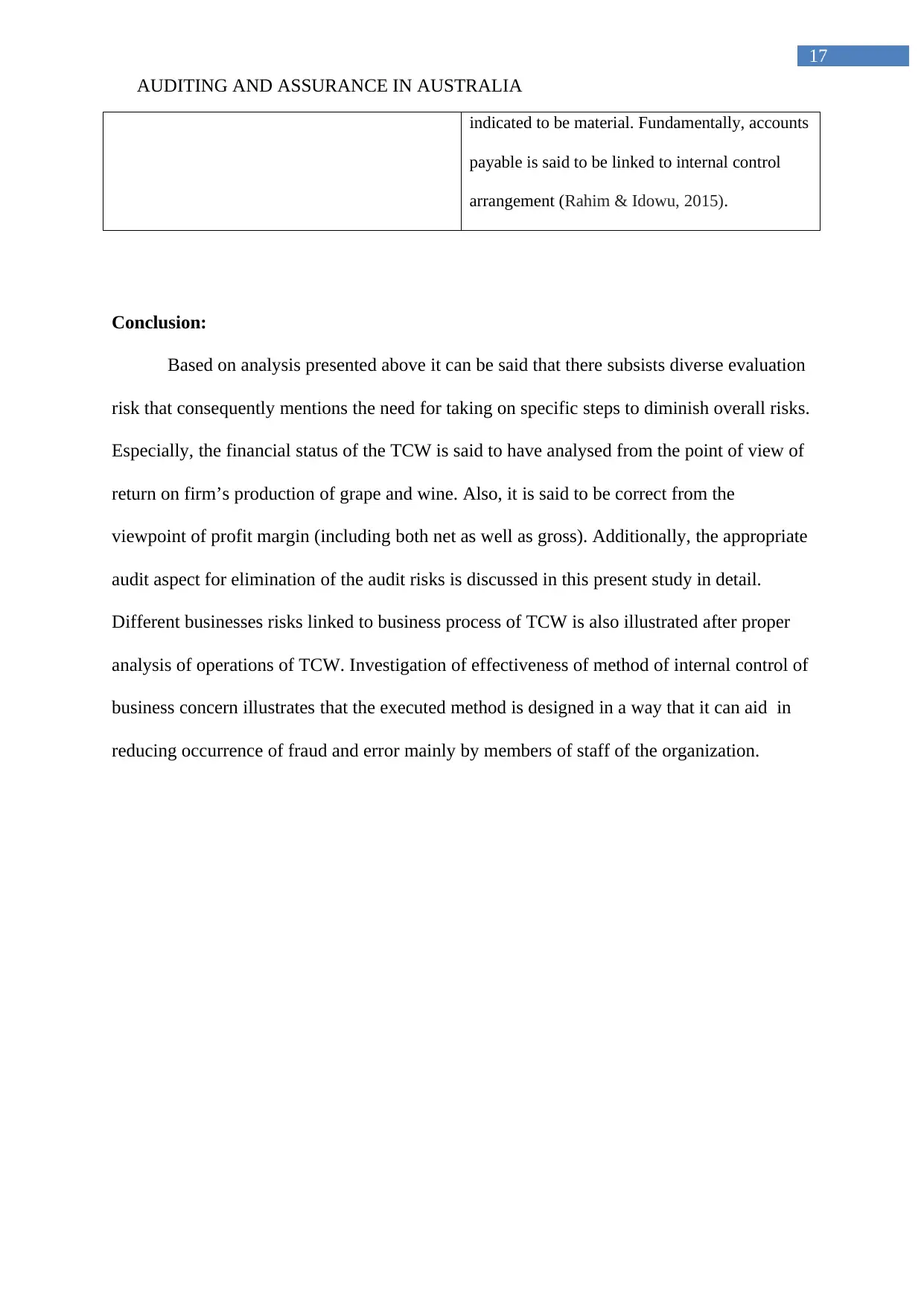
17
AUDITING AND ASSURANCE IN AUSTRALIA
indicated to be material. Fundamentally, accounts
payable is said to be linked to internal control
arrangement (Rahim & Idowu, 2015).
Conclusion:
Based on analysis presented above it can be said that there subsists diverse evaluation
risk that consequently mentions the need for taking on specific steps to diminish overall risks.
Especially, the financial status of the TCW is said to have analysed from the point of view of
return on firm’s production of grape and wine. Also, it is said to be correct from the
viewpoint of profit margin (including both net as well as gross). Additionally, the appropriate
audit aspect for elimination of the audit risks is discussed in this present study in detail.
Different businesses risks linked to business process of TCW is also illustrated after proper
analysis of operations of TCW. Investigation of effectiveness of method of internal control of
business concern illustrates that the executed method is designed in a way that it can aid in
reducing occurrence of fraud and error mainly by members of staff of the organization.
AUDITING AND ASSURANCE IN AUSTRALIA
indicated to be material. Fundamentally, accounts
payable is said to be linked to internal control
arrangement (Rahim & Idowu, 2015).
Conclusion:
Based on analysis presented above it can be said that there subsists diverse evaluation
risk that consequently mentions the need for taking on specific steps to diminish overall risks.
Especially, the financial status of the TCW is said to have analysed from the point of view of
return on firm’s production of grape and wine. Also, it is said to be correct from the
viewpoint of profit margin (including both net as well as gross). Additionally, the appropriate
audit aspect for elimination of the audit risks is discussed in this present study in detail.
Different businesses risks linked to business process of TCW is also illustrated after proper
analysis of operations of TCW. Investigation of effectiveness of method of internal control of
business concern illustrates that the executed method is designed in a way that it can aid in
reducing occurrence of fraud and error mainly by members of staff of the organization.
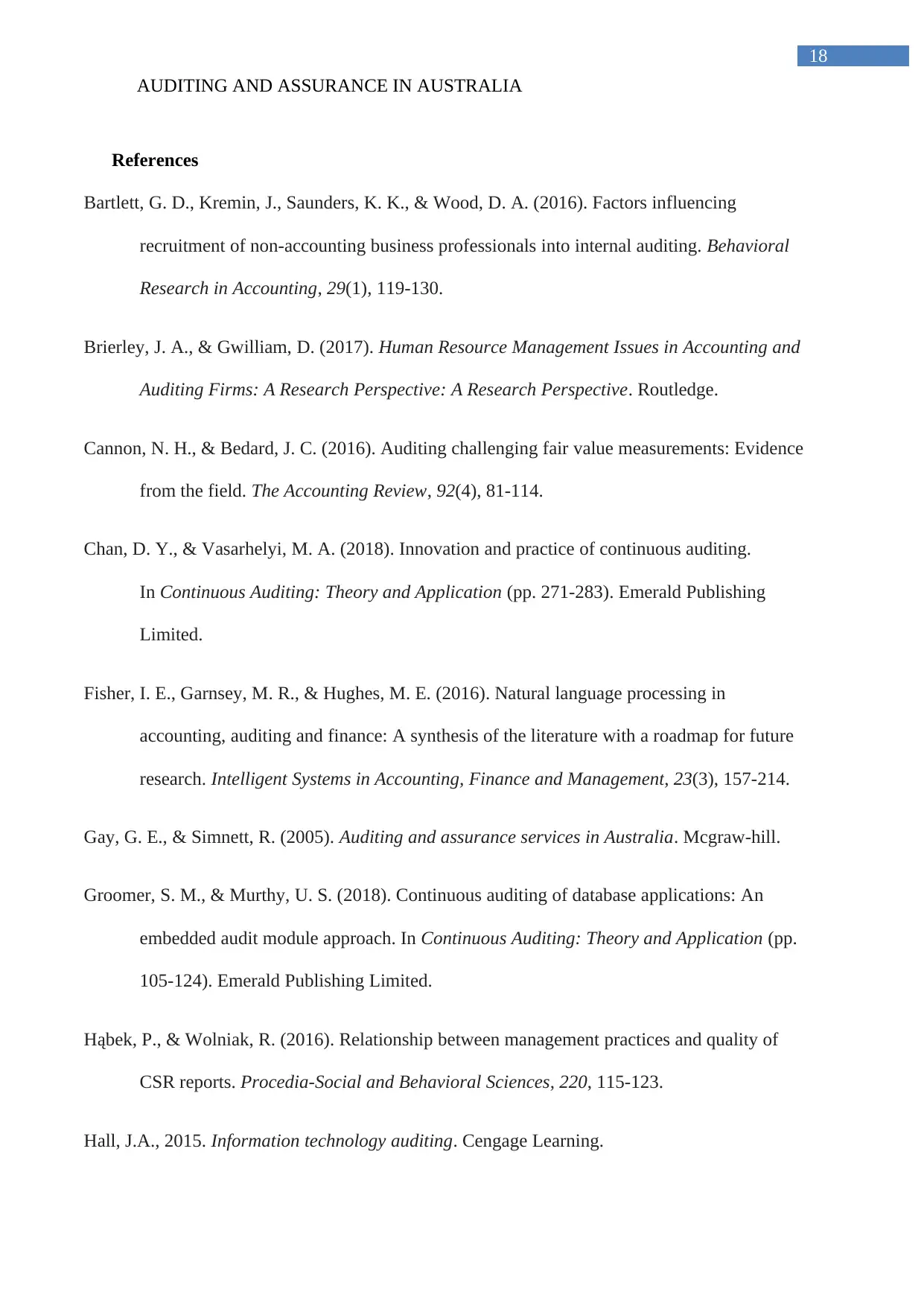
18
AUDITING AND ASSURANCE IN AUSTRALIA
References
Bartlett, G. D., Kremin, J., Saunders, K. K., & Wood, D. A. (2016). Factors influencing
recruitment of non-accounting business professionals into internal auditing. Behavioral
Research in Accounting, 29(1), 119-130.
Brierley, J. A., & Gwilliam, D. (2017). Human Resource Management Issues in Accounting and
Auditing Firms: A Research Perspective: A Research Perspective. Routledge.
Cannon, N. H., & Bedard, J. C. (2016). Auditing challenging fair value measurements: Evidence
from the field. The Accounting Review, 92(4), 81-114.
Chan, D. Y., & Vasarhelyi, M. A. (2018). Innovation and practice of continuous auditing.
In Continuous Auditing: Theory and Application (pp. 271-283). Emerald Publishing
Limited.
Fisher, I. E., Garnsey, M. R., & Hughes, M. E. (2016). Natural language processing in
accounting, auditing and finance: A synthesis of the literature with a roadmap for future
research. Intelligent Systems in Accounting, Finance and Management, 23(3), 157-214.
Gay, G. E., & Simnett, R. (2005). Auditing and assurance services in Australia. Mcgraw-hill.
Groomer, S. M., & Murthy, U. S. (2018). Continuous auditing of database applications: An
embedded audit module approach. In Continuous Auditing: Theory and Application (pp.
105-124). Emerald Publishing Limited.
Hąbek, P., & Wolniak, R. (2016). Relationship between management practices and quality of
CSR reports. Procedia-Social and Behavioral Sciences, 220, 115-123.
Hall, J.A., 2015. Information technology auditing. Cengage Learning.
AUDITING AND ASSURANCE IN AUSTRALIA
References
Bartlett, G. D., Kremin, J., Saunders, K. K., & Wood, D. A. (2016). Factors influencing
recruitment of non-accounting business professionals into internal auditing. Behavioral
Research in Accounting, 29(1), 119-130.
Brierley, J. A., & Gwilliam, D. (2017). Human Resource Management Issues in Accounting and
Auditing Firms: A Research Perspective: A Research Perspective. Routledge.
Cannon, N. H., & Bedard, J. C. (2016). Auditing challenging fair value measurements: Evidence
from the field. The Accounting Review, 92(4), 81-114.
Chan, D. Y., & Vasarhelyi, M. A. (2018). Innovation and practice of continuous auditing.
In Continuous Auditing: Theory and Application (pp. 271-283). Emerald Publishing
Limited.
Fisher, I. E., Garnsey, M. R., & Hughes, M. E. (2016). Natural language processing in
accounting, auditing and finance: A synthesis of the literature with a roadmap for future
research. Intelligent Systems in Accounting, Finance and Management, 23(3), 157-214.
Gay, G. E., & Simnett, R. (2005). Auditing and assurance services in Australia. Mcgraw-hill.
Groomer, S. M., & Murthy, U. S. (2018). Continuous auditing of database applications: An
embedded audit module approach. In Continuous Auditing: Theory and Application (pp.
105-124). Emerald Publishing Limited.
Hąbek, P., & Wolniak, R. (2016). Relationship between management practices and quality of
CSR reports. Procedia-Social and Behavioral Sciences, 220, 115-123.
Hall, J.A., 2015. Information technology auditing. Cengage Learning.
You're viewing a preview
Unlock full access by subscribing today!
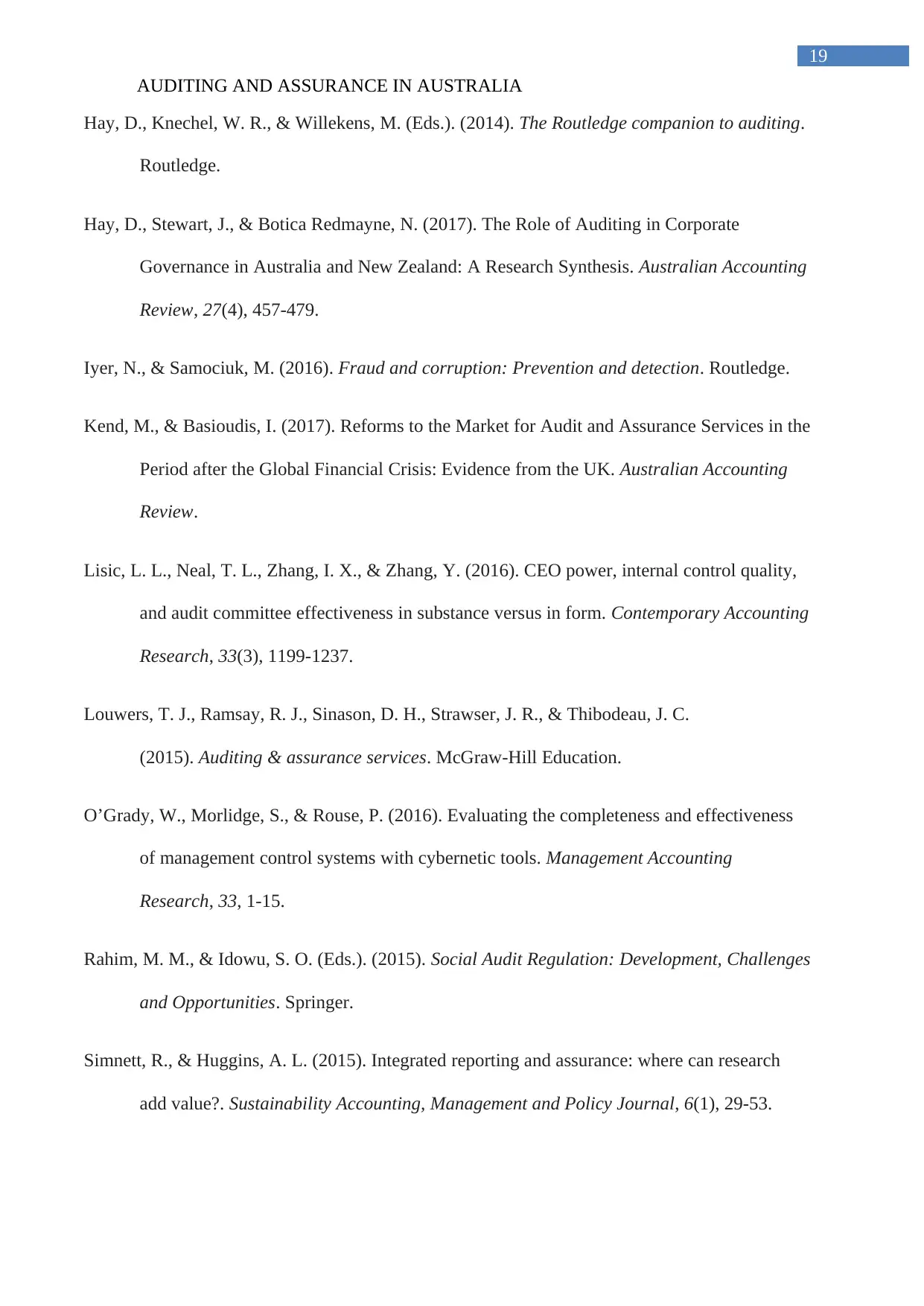
19
AUDITING AND ASSURANCE IN AUSTRALIA
Hay, D., Knechel, W. R., & Willekens, M. (Eds.). (2014). The Routledge companion to auditing.
Routledge.
Hay, D., Stewart, J., & Botica Redmayne, N. (2017). The Role of Auditing in Corporate
Governance in Australia and New Zealand: A Research Synthesis. Australian Accounting
Review, 27(4), 457-479.
Iyer, N., & Samociuk, M. (2016). Fraud and corruption: Prevention and detection. Routledge.
Kend, M., & Basioudis, I. (2017). Reforms to the Market for Audit and Assurance Services in the
Period after the Global Financial Crisis: Evidence from the UK. Australian Accounting
Review.
Lisic, L. L., Neal, T. L., Zhang, I. X., & Zhang, Y. (2016). CEO power, internal control quality,
and audit committee effectiveness in substance versus in form. Contemporary Accounting
Research, 33(3), 1199-1237.
Louwers, T. J., Ramsay, R. J., Sinason, D. H., Strawser, J. R., & Thibodeau, J. C.
(2015). Auditing & assurance services. McGraw-Hill Education.
O’Grady, W., Morlidge, S., & Rouse, P. (2016). Evaluating the completeness and effectiveness
of management control systems with cybernetic tools. Management Accounting
Research, 33, 1-15.
Rahim, M. M., & Idowu, S. O. (Eds.). (2015). Social Audit Regulation: Development, Challenges
and Opportunities. Springer.
Simnett, R., & Huggins, A. L. (2015). Integrated reporting and assurance: where can research
add value?. Sustainability Accounting, Management and Policy Journal, 6(1), 29-53.
AUDITING AND ASSURANCE IN AUSTRALIA
Hay, D., Knechel, W. R., & Willekens, M. (Eds.). (2014). The Routledge companion to auditing.
Routledge.
Hay, D., Stewart, J., & Botica Redmayne, N. (2017). The Role of Auditing in Corporate
Governance in Australia and New Zealand: A Research Synthesis. Australian Accounting
Review, 27(4), 457-479.
Iyer, N., & Samociuk, M. (2016). Fraud and corruption: Prevention and detection. Routledge.
Kend, M., & Basioudis, I. (2017). Reforms to the Market for Audit and Assurance Services in the
Period after the Global Financial Crisis: Evidence from the UK. Australian Accounting
Review.
Lisic, L. L., Neal, T. L., Zhang, I. X., & Zhang, Y. (2016). CEO power, internal control quality,
and audit committee effectiveness in substance versus in form. Contemporary Accounting
Research, 33(3), 1199-1237.
Louwers, T. J., Ramsay, R. J., Sinason, D. H., Strawser, J. R., & Thibodeau, J. C.
(2015). Auditing & assurance services. McGraw-Hill Education.
O’Grady, W., Morlidge, S., & Rouse, P. (2016). Evaluating the completeness and effectiveness
of management control systems with cybernetic tools. Management Accounting
Research, 33, 1-15.
Rahim, M. M., & Idowu, S. O. (Eds.). (2015). Social Audit Regulation: Development, Challenges
and Opportunities. Springer.
Simnett, R., & Huggins, A. L. (2015). Integrated reporting and assurance: where can research
add value?. Sustainability Accounting, Management and Policy Journal, 6(1), 29-53.
Paraphrase This Document
Need a fresh take? Get an instant paraphrase of this document with our AI Paraphraser
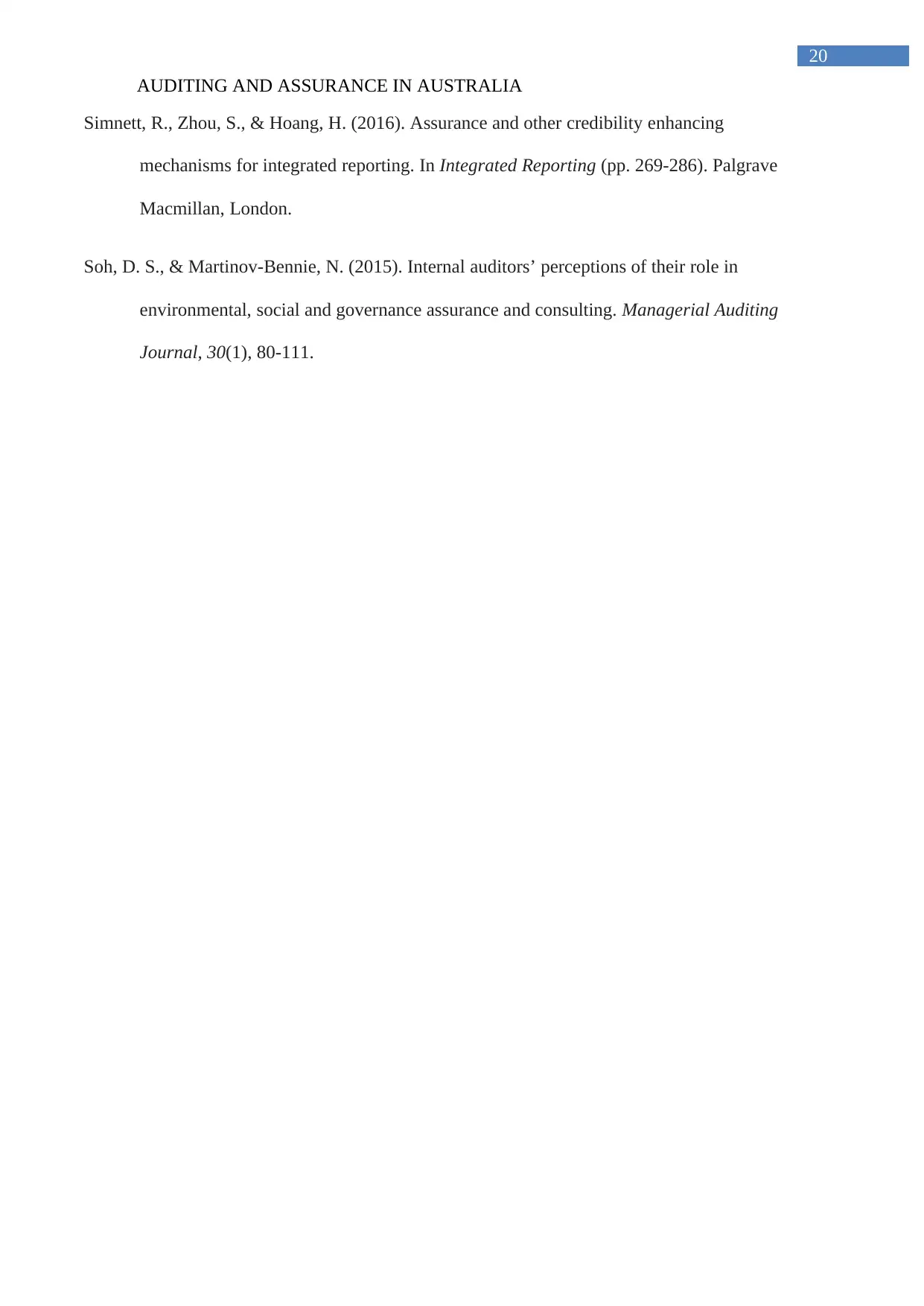
20
AUDITING AND ASSURANCE IN AUSTRALIA
Simnett, R., Zhou, S., & Hoang, H. (2016). Assurance and other credibility enhancing
mechanisms for integrated reporting. In Integrated Reporting (pp. 269-286). Palgrave
Macmillan, London.
Soh, D. S., & Martinov-Bennie, N. (2015). Internal auditors’ perceptions of their role in
environmental, social and governance assurance and consulting. Managerial Auditing
Journal, 30(1), 80-111.
AUDITING AND ASSURANCE IN AUSTRALIA
Simnett, R., Zhou, S., & Hoang, H. (2016). Assurance and other credibility enhancing
mechanisms for integrated reporting. In Integrated Reporting (pp. 269-286). Palgrave
Macmillan, London.
Soh, D. S., & Martinov-Bennie, N. (2015). Internal auditors’ perceptions of their role in
environmental, social and governance assurance and consulting. Managerial Auditing
Journal, 30(1), 80-111.
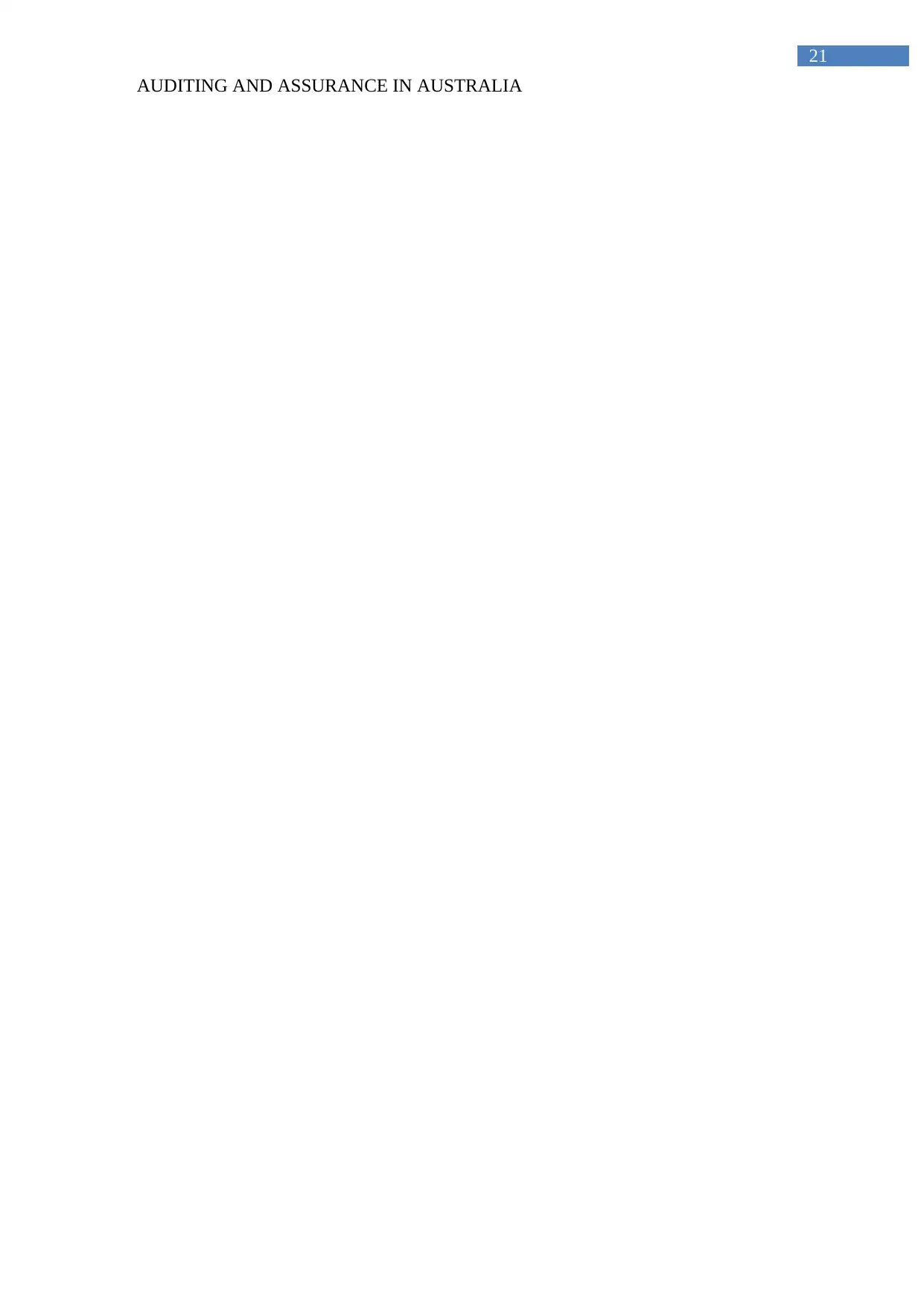
21
AUDITING AND ASSURANCE IN AUSTRALIA
AUDITING AND ASSURANCE IN AUSTRALIA
You're viewing a preview
Unlock full access by subscribing today!
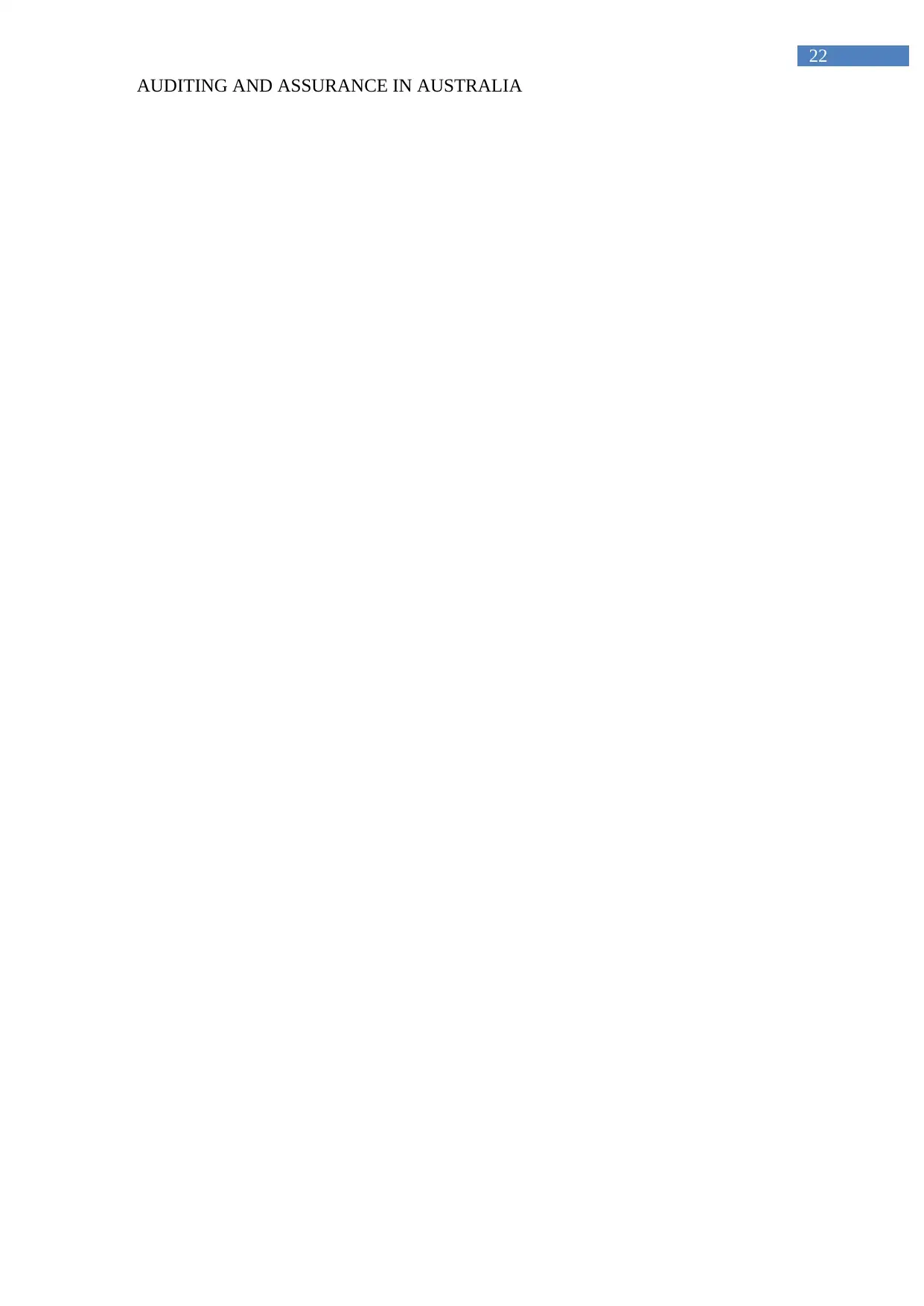
22
AUDITING AND ASSURANCE IN AUSTRALIA
AUDITING AND ASSURANCE IN AUSTRALIA
1 out of 22
Related Documents
Your All-in-One AI-Powered Toolkit for Academic Success.
+13062052269
info@desklib.com
Available 24*7 on WhatsApp / Email
![[object Object]](/_next/static/media/star-bottom.7253800d.svg)
Unlock your academic potential
© 2024 | Zucol Services PVT LTD | All rights reserved.



